
Constellations Summary
Cat: SCI
Pub:2017
#1704a
IAU, Wikipedia, et al.
17322u/18227r
Pinyin
Index
; And ; Ant ; Aps ; Aqr ; Aql ; Ara ; Ari ; Aur ; Boo ; Cae ; Cam ; Cnc ; CVn ; CMa ; CMi ; Cap ; Car ; Cas ; Cen ; Cep ; Cet ; Cha ; Cir ; Col ; Com ; CrA ; CrB ; Crv ; Crt ; Cru ; Cyg ; Del ; Dor ; Dra ; Equ ; Eri ; For ; Gem ; Gru ; Her ; Hor ; Hya ; Hyi ; Ind ; Lac ; Leo ; LMi ; Lep ; Lib ; Lup ; Lyn ; Lyr ; Men ; Mic ; Mon ; Mus ; Nor ; Oct ; Oph ; Ori ; Pav ; Peg ; Per ; Phe ; Pic ; Psc ; PsA ; Pup ; Pyx ; Ret ; Sge ; Sgr ; Sco ; Scl ; Sct ; Ser ; Sex ; Tau ; Tel ; Tri ; TrA ; Tuc ; UMa ; UMi ; Vel ; Vir ; Vol ; Vul ;
- Mythology of constellation seems historically established mnemonics to remeber the positions of stars. The story and topics of costellations contain cultural and scienctifc knowledge as well as affluent imagination.
- 星座についての神話は星の位置を覚える上で、歴史的に確立された記憶法である。星座に関する物語や話題には様々な想像と共に文化的・科学的な知識が含まれている。
#
V
Mv
Ra
Dec
Proper name of 1st magnitude ★
Kº
Spe: OBAFGKM
ly
M⦿
R⦿
L⦿
Type
0
-26.74
4.82
Sun ⦿; 太阳 tàiyáng
6
G2V
0.0000158
1
-1.46
1.42
06.45
-16.42
Sirius (α CMa) 天狼星 tiānláng xīng
25
A1, DA2
8.6
0.98
0.0084
0.056
Bin
2
-0.74
-5.71
06.23
-52.41
Canopus (α Car) 老人 lǎorén xīng
7
A9II
310
8.0
71
10.7K
3
-0.27
4.38
14.39
-60.50
Rigil Kentaurus (α Cen) 南門二 nánmén èr
5.8
G2V, K1V
4.37
1.1
1.23
0.5
Bin
4
-0.05
-0.30
14.15
+19.10
Arcturus (α Boo) 大角 dàjiǎo
4.3
K0Ⅲ
37
1.08
25.4
170
5
0.03
0.58
18.36
+38.47
Vega (α Lyr) 织女一 zhīnǚ yī
9.6
A0Va
25
2.14
2.36
40.1
Var
6
0.08
0.17
05.16
+45.59
Capella (α Aur) 五车二 wǔchē èr
5.7
K0Ⅲ, G1Ⅲ
42
2.57
11.98
78.7
Bin
7
0.13
-7.84
05.14
-08.12
Rigel (β Ori) 参宿七 cānsù qī
11
B8Ia, B9V
860
23
78.9
120K
Bin
8
0.34
2.66
07.39
+05.13
Procyon (α CMi) 南河三 nánhé sān
6.5
F5 IV-V
11
1.50
2.05
6.93
Bin
9
0.46
-1.46
01.37
-57.14
Achernar (α Eri) 水委一 shuǐwěi yī
15
B6Vep
139
6.7
7.3
3150
10
0.50
-5.85
05.55
+07.24
Betelgeuse (α Ori) 参宿四 cānsù sì
3.6
M1Ia, M2Iab
640
11.6
887
90K
Bin
11
0.61
-4.53
-4.53
-60.22
Hadar (β Cen) 马腹一 mǎfù yī
25
B1III, ", B1V
390
10.7
41.7
Tri
12
0.76
2.22
19.50
+08.52
Altair (α Aql) 河鼓二 hégǔ èr
6.9
A7 V
17
1.79
1.63
10.6
13
0.76
3.77
12.26
-63.05
Acrux (α Cru) 十字架二 shízìjià èr
28
B0.5 IV, B1 V
320
17.8
25K
14
0.86
-0.64
04.35
+16.30
Aldebaran (α Tau) 毕宿五 bìsù wǔ
3.9
K5Ⅲ
65
1.5
44.2
518
15
0.96
-5.28
16.29
-26.25
Antares (α Sco) 心宿二 xīnsù èr
3.5
M1.5 lab, B3V
600
12.4
883
57.5K
Bin
16
0.97
-3.55
13.25
-11.09
Spica (α Vir)角宿一 jiǎosù yī
22.4
B1Ⅲ-Ⅳ, B2V
250
10.25
7.4
12.1K
Bin
17
1.14
1.08
07.45
+28.01
Pollux (β Gem) 北河三 běihé sān
3.9
K0Ⅲ
34
2.04
8.8
43
18
1.16
1.72
22.57
-29.37
Fomalhaut (α PsA) 北落师门 běiluòshī mén
8.6
A3V, K5Vp, M4V
25
1.92
1.84
16.6
Trip
19
1.25
-8.38
20.41
+45.16
Deneb (α Cyg) 天津四 tiān jīn sì
8.5
A2Ia
2600
19
203
196K
20
1.25
-3.36
12.47
-59.41
Mimosa (β Cru) 十字架三 shízìjià sān
27
B0.5Ⅲ, B2V
280
16
8.4
34K
Bin
21
1.40
-0.52
10.08
+11.58
Regulus (α Leo) 轩辕十四 xuānyuán shísì
13
B8V, K2V, M4V
79
3.8
3.1
288
Bin×2
51
1.98
-3.6
02.31
+89.15
Polaris (α UMi) 勾陈一 gōuchén yī
6
F7Ib
323
5.4
37.5
1260
Tri
#
V
Mv
Ra
Dec
Proper name
Kº
Spectrum
ly
M⦿
R⦿
L⦿
Type
North (Ra: 21h - 03h)
East (Ra: 03h - 09h)
South (Ra: 09h - 15h)
West (Ra: 15h -21h)
Dec (+)
2115+5 αEqu; 2118+62 αCep; 22.31+30 αLac; 0008+29 αAnd; 0040+56 αCas; 0131+15 ηPsc; 0207+23 αAri; 0209+34 βTri; 0231+89 Polaris;
0324+49 αPer;
0435+16 Aldebaran;
0440-41 αCae; 0503+60 βCam; 0516+45 Capella; 0555+07 Betelgeuse; 0739+05 Procyon; 0745+28 Pollux; 0803-40 ζPup; 0816+09 βCnc;
0921+34 αLyn; 1008+11 Regulus;
1053+34 46LMi; 1254+55 εUMa; 1256+38 αCVn; 1311+27 βCom; 1415+19 Arcturus;
1534+26 αCrB; 1630+21 βHer; 1734+12 αOph; 1756+51 γDra;
1836+38 Vega; 1928+24 αVul;
1950+08 Altair; 1958+19 γSge;
2037+14 βDel; 2041+45 Deneb;
Dec (-)
213-05 βAqr; 2101-32 γ Mic; 2147-16 δCap; 2208-46 αGru; 2218-60 αTuc;
2257-29 Fomalhaut;
2352-82 νOct; 0026-42 αPhe; 0043-17 βCet; 0137-57 Achernar; 0158-61 αHyi;
0312-28 αFor; 0414-42 αHor;
0414-62 αRet; 0433-55 αDor; 0440-41 αCae; 0514-08 Rigel;
0532-17 αLep; 0539-34 αCol;
0623-52 Canopus; 0628-07 βMon; 0645-16 Sirius;
0809-47 γVel; 0818+09 αCha;
0927-08 αHya; 1007-0.2 αSex; 1027-31 αAnt; 1124-17 δCrt; 1215-17 γCrv; 12.26-63 Acrux; 1247-59 Mimosa; 1325-11 Spica; 1403-60 Hadar; 1439-60 Rigel-Ken; 1442-64 αCir; 1447-79 αAps;
1517-09 βLib; 1619-50 γ2Nor; 1629-26 Antares; 1648-69 αTrA; 1725-55 βAra; 1826-45 αTel; 1909-37 αCrA; 2025-56 αPav; 2037-47 αInd;
>Top <Location>:
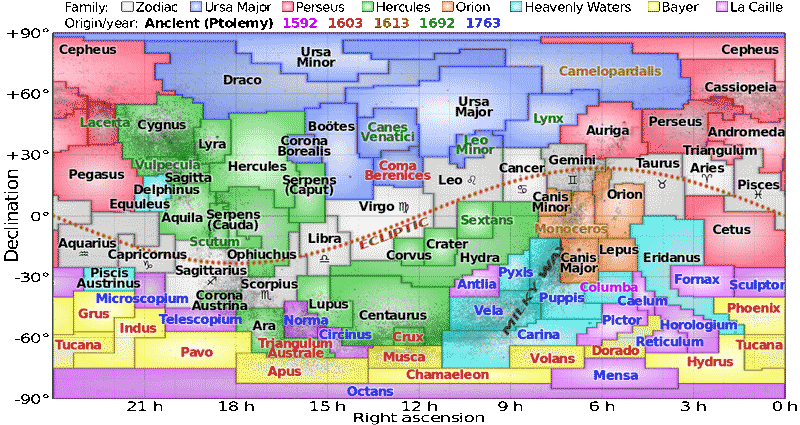
>Top Apparent magnitude (V), Absolute magnitude (Mv) &
Spectrum Type (OBAFGKM):
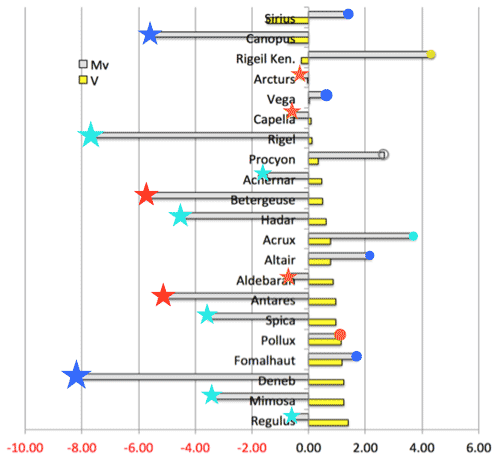
>Top Distance (ly) & Absolute magnitude (Mv):
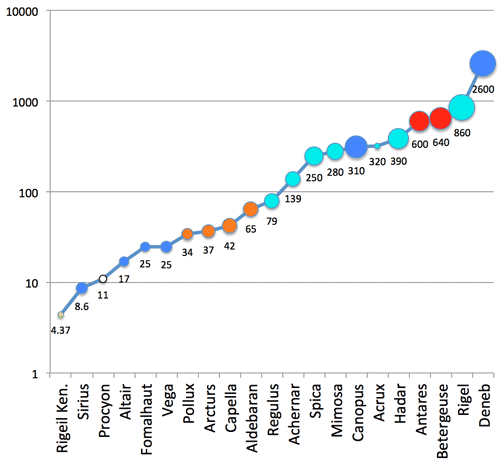
Data
Mithology & History
Map
>Top <Andromeda ; And>
- ☆α And (Alpheratz); B-Type the brightest binary star, mag 2.06, Mv -0.19 at 97 ly, with 96 L⦿. has also been counted as a part of Pegasus.
- ☆β And (Mirach); M-Type red giant variable, known as 'gircle', mag 2.05 Mv -1.76 at 200 ly, with 3-4 M⦿, 100 R⦿, 1995 L⦿.
- ☆γ And (Almach, 'colorful') K/B/B/A-type orange bright giant, quadruple star system, mag 2.26 Mv -2.9 at 350 ly; 80 R⦿, 2000 L⦿.

- Only maginally dimmer than α, β Andromedae is a red giant.
- The Great Galaxy of Andromeda, the closest spiral galaxy to the Milky Wasy, one the brightest Messier objects, M31 and its companion M110 <Fig>
- Planetary nebula; NGC7662 known as Blue Snowball Nebula <Fig>
- Andromeda, daughter of Cassiopeia (Queen of Ethiopia), who was chained to a rock to sacrifice to the sea monster Cetus, but was saved by the hero Perseus used the head of Medusa to turn the monster into stone. Perseus and Andromeda then married, having nine children, 7 sons and 2 daughters.
- Later Athena place her in the sky as a constellation to honor her. There are sevel neighboring constellations (Perseus, Cassiopeia, Cetus, and Cepheus).
- <Fig> Galaxy of Andromeda and NGC7662:
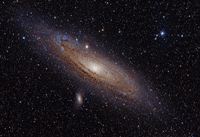
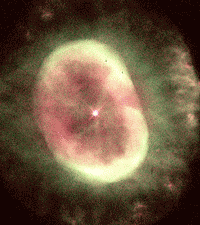
Andromeda(アンドロメダ座, 仙女座xiānnǚ); And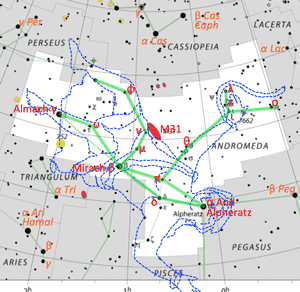
>Top <Antlia, Ant>
- A small constellation in the southern sky; its name means <L. 'pump'; an air pump.
- α Ant; K-type brightest, variable, mag. 4.22 Mv -1.0 at 370 ly; 2.2 M⦿, 53 R⦿, 555 L⦿.
- Originally Antlia Pneumatica, established by Nocolas-Louis de Lacaille in 18C.
Antlia (ポンプ座; 唧筒座 jītǒng zuò); Ant
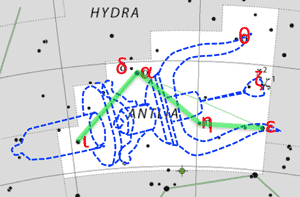
>Top <Apus, Aps>
- A small constellation in the southern sky; it represents a bird-of-paradise, and its name means <G. 'without feet', which was once wrongly believed to lack feet.
- α Aps; K-type brightest, mag 3.83 Mv -1.86 at 447 ly; 48 R⦿, 928 L⦿; This is a circumpolar star for most of the southern hmisphere.
- γ Aps; G-type, mag 3.86 at 156 ly.
- δ Aps; M/K-type double, mag 5.27 at 610 ly.
- French explorer & astronomer Nicolas Louis de Lacaille charted in 1756.
- Then the only specimens of the bird-of-paradise remained in the West had their feet and wings removed. Such specimen began to arrive in Europe in 1522 when the survivors of Ferdinand Magellan's expedition brought them home.
- <Fig> α Aps to the South Pole:
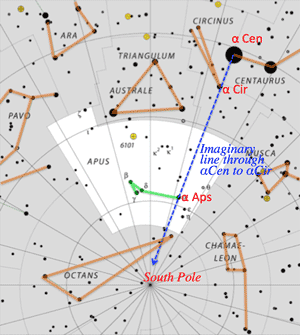
Apus (風鳥座; 天燕座 tiānyàn zuò); Aps

>Top <Aquarius, Aqr>
- One of zodiac constellations, has no particular bright stars.
- α Aqr (Sadalmelik); G-type mag. 2.94, and 6.5 M⦿, 3000 time luminous ⦿, and 520 ly.
- β Aqr (Sadalsuud, 'luck of lucks'); G-type brightest, mag 2.89 at 540 ly; 6.6 M⦿, 50 R⦿, 6.4 M⦿, 2300 L⦿.
- γ Aqr (Sadchbia); A-type (<Ar. lucky stars of the tents), mag 3.8 in 164 ly.
- δ Aqr (Skat); A-type, mag 3.25 at 160 ly.
- Planetary systems: Gliese 876, 15 ly has four planets, including 6.6 M⊕
- In Greek mythology, is associated with Deucalion, the son of Poor-mouths who built a ship with his wife Pyorrhea to survive an imminent flood.
- Aquarius is also identified with beautiful Ganymede, the son of Trojan king Trows, who was taken to MT. Olympus by Zeus to act as cup-carrier to the gods.
- Ganymede's kidnapping by the goddess of the dawn, Eos, motivated by her affection for young men; Zeus then stole him from Eos and employed him as cup-bearer.
- Water bearer is Scrapes I, a king of Ethane who sacrificed water instead of wine to the gods.
Aquarius (水瓶座; 宝瓶座 bǎopíng zuò); Aqr
<News 2017/2 by NASA> TRAPPIST-1
- An ultracool dwarf star in Aqr, 2000 time dimmer than ⦿, slightly larger than Jupiter, with 39 ly away. It radiates in infrared rather than visible wavelength (daytime skies would be salmon-colored like just after sunset).
- Even the most distant plant's orbital period is about 20 days. The planet tug and pull each other as go orbiting around. It's very likely 7 planets are tidally locked facing the star.
- It has 7 Earth-size planets, 3 of them belong to habitable zone. Without an atmosphere, water won't remain liquid in space.
- A neighboring planet might appear twice as large as the full moon. It takes about 200 years by 20% of light speed. The 7 planets orbit closer to their star than Mercury orbits.
Trappist-1: compared by Jupiter.
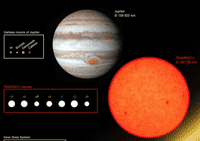
Travel poster to Trappist-1:
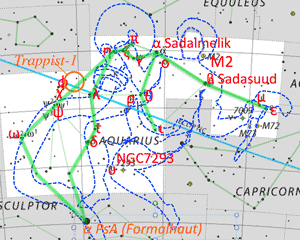
>Top <Aquila, Aql>
- ★α Aql (Altair); A-type the brightest star, mag 0.76 at 17 ly,<Ar 'al-nasr al-tair 'the flying eagle', 1.8 M⦿, 1.6 R⦿, 10.6 L⦿.
- β Aql (Alshain); G-type, mag 3.71, 45 ly; <Ar shahin-i tarazu 'the balance'; 1.26 M⦿, 3.28 R⦿. 6.0 L⦿.
- γ Aql (Tarazed); K-type, mag 2.71 at 395 ly; 5.66 M⦿, 95 R⦿, 2538 L⦿.
- ζ Aql; A-type, mag 2.98 at 83 ly.
- η Aql; F/B/F-type, mag 3.87 at 1400 ly, among the brightest Cepheid variable stars.
- Its name <L. 'eagle' represents the bird who carried Zeus thunderbolts in Greco-Roman mythology.
- Aquila is also associated with the eagle who kidnapped Ganymede, a son of one of the kings of Troy to Mt. Olympus to serve as cup-bearer to the gods. (Cf. Aquarius)
Aquila (鷲座; 天鹰座; tiānyīng zuò)
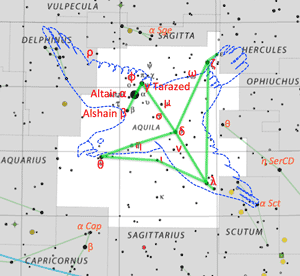
>Top <Ara, Ara>
- α Ara; B-type, mag 2.93 at 270 ly.; 9.6 M⦿, 4.5 R⦿, 5800 L⦿.
- β Ara; K-type the brightest, mag 2.84 Mv -3.49 at 650 ly; marginally brighter than α; 8.21 M⦿, 5636 L⦿.
- μ Ara; G-type, mag 5.12 at 50.6 ly; host 4 planets; 1.1 M⦿, 1.36 R⦿. 1.90 L⦿.
- In Greek mythology, Ara was identified as the altar where the gods first made offerings and formed an alliance before defeating the Titans. The nearby Milky Way represents the smoke rising from the offerings on the altar.
- It had been recorded by Aratus in 270BC.
- Ara is usually depicted as an altar with its smoke rising southward.
Ara (祭壇座; 天坛座 tiāntán zuò); Ara
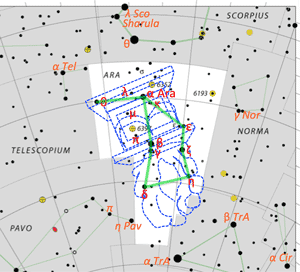
>Top <Aries, Ari>
- ☆α Ari (Hamal) <Ar. al-hamal, head of the ram; K-type brightest orange giant, mag 2.00 Mv 0.49 at 66 ly; 1.5 M⦿, 14.9 R⦿, 91 L⦿.; has a planet bigger thatn Mj.
- β Ari (Sheratan); A-type blue-white star, mag. 2.65 at 59.6 ly; 2.34 M⦿, 23 L⦿.
- γ Ari (Mesarthim), <Ar. al-sharatan, pair; B/A- type binary of mag 3.86 at 164 ly.
- Deep-sky objects; NGC 772, mag 11.1 at 130M ly; twice size of Milky Way.
- Aries is a zodiac constellation; Aries is Latin for ram whose fleece became the Golden Fleece of Greek mythology.
- Aries has bee depicted as a crouched, wingless ram with its head turned toward Taurus.
- The First Point of Aries, the location of he vernal equinox, is named for the constellation.
Aries (牡羊座;
白羊座 báiyáng zuò); Ari
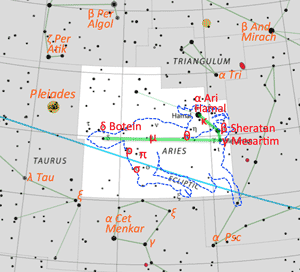
>Top <Auriga, Aur>
- ★α Aur (Capella); (<al-Ayyuq, the goat) K/G-type the brightest binary star, the nearest 1st magnitude circumpolar star, mag 0.08 Mv -0.51 at 43 ly; Aa 2.56 M⦿, 11.9 R⦿, 78.7 L⦿.; used to be mag -1.8 the brightest in the sky about 160-210K years ago.
- ☆β Aur (Menkalinan); A-type binary mag 1.90 Mv -0.08 at 81 ly; 2.39 M⦿, 2.77 R⦿, 48 L⦿.
- α Aur: Sometimes called 'Goat Star' <Ar al-ayuuq, the goat
- β Aur: <Ar al-inan, 'shoulder of the charioteer.
Auriga (馭者座; 御夫座 yùfū zuò); Aur
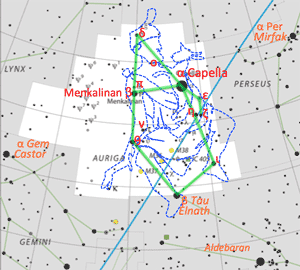
>Top <Boötes, Boo>:
- ★α Boo (Arcturus); K-type the brightest star, K-type mag -0.05, Mv -0.30 at 36.7 ly; 1.08 M⦿, 25.4 R⦿, 170 L⦿.
- β Boo (Nekkar); G-type yellow giant, mag 3.49 at 219 ly; marking the herdsman's head.
- γ Boo (Seginus); A-type white giant, mag 3.04 at 85 ly.
- δ Boo (Scuti); G-type, binary, mag 3.48 at 117 ly.
- ρ Boo; K-type, mag 3.57 at 149 ly.
- ζ Boo; A-type, mag 3.78 at 180 ly.
- θ Boo; F-type, mage 4.04 at 48 ly.
- μ1 Boo (Alkalurops); F/G-type, triple, <Ar 'club', mag 4.31 at 121 ly.
- σ Boo; F-type, mag 4.47 at 50 ly.
- υ Boo; K-type, mag 4.05 at 245 ly.
- ☆ε Boo (Izar or Pulcherrima); A/K-type close triple, most prominent binary star in Bootes; <Ar. 'girdle', referring to its location in the constellation, mag 2.35 Mv -1.58 at 210 ly.
- η Boo (Muphrid); G-type, mag 2.68 at 37 ly; uppermost star denoting the left leg; Muphride and Arcturus lie only 3.3 ly away from each other. Arcturus would be around mag -4.5 when seen from Muphrid.
- The name Boötes was first used by Homer in his Odyssey as a celestial reference point for navigation; as late-setting.
- He was a son of Demeter, Philomenus, twin brother of Plutus, a ploughman who drove the oxen in Ursa Major. The ancient Greek saw the asterism of Big Dipper as a cart with oxen.
- Another myth associated that Icarius made wine so strong that those who drank it appeared poisoned, which caused shepherds to avenge their supposedly poisoned friends by killing Icarius. Maera, Icarius's dog, brought his daughter Erigone to her father's body, whereupon both she and the dog committed suicide. Zeus then chose to honor all three by placing them in the sky Icarius as Boötes, Erigone as Virgo, and Maera as Canis Major or Canis Minor.
Boötes (牛飼い座; 牧夫座 mùfū zuò); Boo
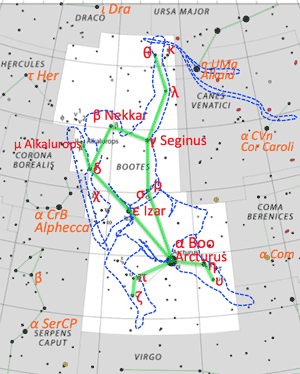
>Top <Caelum, Cae>:
- α Cae; F/M-type brightest, double star; mag 4.45 at 66 ly.; 1.48 M⦿, 1.3 R⦿.
- γ1 Cae; K-type, mag 4.58 at 185 ly.
- δ Cae; B-type, mag 5.07 at 711 ly.
- It is a faint constellation in the southern sky, introduced in 1750s by Nicolas Louis de Lacaille, its name mans 'chiesel' in Latin; originally Latinized to Calum Scalptorium ('the engravers' chisel')
- Due to its small size and location away from the plane of the Milky Way, Caelum is a rather barren constellation.
Caelum (彫刻具座; 雕具座 diāojù zuò); Cae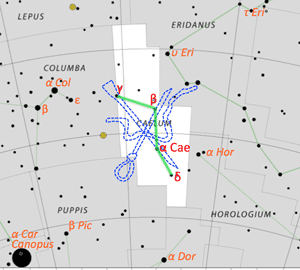
>Top <Camelopardalis, Cam>
- α Cam; O-type, mag 4.29 at 6000 ly; one of the most distant stars easily visible with naked eye; 30.9 M⦿, 29 R⦿, 620,000 L⦿.
- β Cam; G-type the brightest double, mag 4.02 Mv -3.11 at 870 ly; 6.5 M⦿, 1592 L⦿.
- 11 Cam; B-type, mag 5.03 at 700 ly; 18 M⦿, 7 R⦿, 20000 L⦿; forming the head of the giraffe.
- Camelopardlis constellation is a large, faint of stars, introduced in 1612 by Petrus Plancius.
- First attested in English in 1785, the word camelopardalis comes from Latin, mening 'giraffe', <G. kamēlos, 'camel'+ pardalis, 'leopard', due to its having a long neck like a camel and spots like a leopard.
- The space probe Voyager-1 is moving to this constellation, though it will not be nearing any of the stars for many thousand of years.
Camelopardalis (麒麟座; 鹿豹座 lùbào zuò); Cam
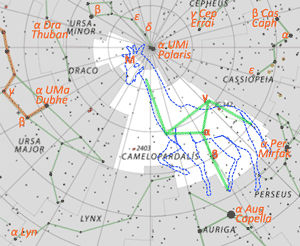
>Top <Cancer, Cnc>
- One of the zodian constellations.
- α Cnc (Acubens); A-type white star, mag 4.20 at 174 ly.
- β Cnc; K-type the brightest binary, mag 3.50 Mv -1.32 at 290 ly; 61 R⦿, 871 L⦿.
- δ Cnc (Asellus Australis); K-type orange giant, mag 3.94 at 131 ly; 11 M⦿, 53 L⦿.
- M44 (Praesepe, 'manger'); an open cluster (Beehive Cluster) contains about 50 stars, mag 3.7 at 577 ly; 500-600
- In Greek mythology, Cancer is identified with the crab that appeared while Hercules was fighting the many-headed Hydra (as one of 12 Labors of Hercules). The crab bit Hercules on the foot, Hercules crushed it and the the goddess Hera, a sworn enemy of Hercules, placed the crab among the stars.
- Sanskrit name of Cancer is Karka and Karkata.
Cancer (蟹座;巨蟹座 jùxiè zuò); Cnc
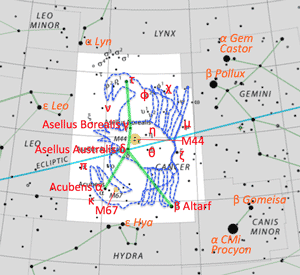
>Top <Canes Venatici, CVn>
- α2 CVn (Cor Caroli); A-type binary, the brightest mag 2.84 Mv 0.3 and at 110 ly; 4.1 R⦿.
- β CVn (Chara); G-type yellow, mag 4.26 at 27 ly; 1.02 M⦿, 1.12 R⦿, 1.15 L⦿.
- The Giand Void; an extremely large void within the vicinity of this constellation.
- M51; group galaxies; Whirlpool Galxy (M51A) and NGC 5195. This was the first galaxy having a face-on spiral structure observed in 1845, with 37M ly, widely considered to be one of the mst beautiful galxies visible. <Fig>

- A small northern constellation created by Johannes Hevelius in 17C. Its name is Latin for 'hunting dogs', as representing the dogs of Boötes. Boötes's stars were traditionally described as representing the club of Boötes.
- During the translation from Greek via Arabic to Latin, the Arabic work (kilāb, the plural of kalb, meaning 'dogs', writing 'spearshaft having dogs'.
- In 1687, Hevelius decided to make as a separate constellation, choosing the name of stars as Asterion 'little star', and Chara 'joy'.
Canes Venatici (猟犬座; 猎犬座 lièquǎn zuò); CVn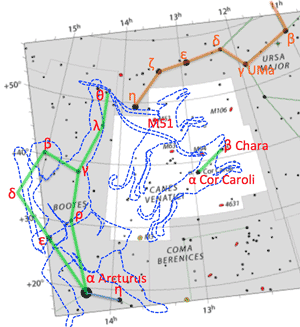
>Top <Canis Major, CMa>
- Canis Major is a prominent constellation because of its many bright stars.
- ★α CMa (Sirius)(<G. scorching'); A-type brightest star in the sky, mag -1.46 Mv 1.42 at 8.60 ly, as well as three other stars above mag 2.0. Sirius means 'scorching' or 'searing' in Greek. Furthermore two other stars are thought to have previously outshone all others in the sky; ε CMa (Adhara) shone at -3.99 around 4.7ma, and β CMa (Mirzam) peaked at -3.65 around 4.42ma. Sirius is a binary star; its companion Sirius B is white dwarf mag 8.4, 10K times fainter than Sirius A, the two orbit each other every 50 years.; α CMa-A, 2.02 M⦿, 1.71 R⦿, 25.4 L⦿.
- ☆β CMa (Mirzam); B-type, mag 1.98 at 490 ly, nickname 'announcer'; 13.5 M⦿, 9.7 R⦿, 26600 L⦿.
- γ CMa (Murzim); B-type, mag 4.10 at 440 ly, known as Muliphein.
- ☆δ CMa (Wezen); F-type, mag 1.82 Mv -6.62 at 1800 ly, 17 R⦿, 237 R⦿, 82,000 L⦿.
- ☆ε CMa (Adhara); B-type, mag 1.50 Mv -4.8 at 430 ly; 12.6 M⦿, 13.9 R⦿, 38,700 L⦿.
- ☆η CMa (Aludra); B-type, mag 2.45 Mv -7.0 at 2000 ly; 19 M⦿, 56 R⦿, 105,400 L⦿.
- VY CMa; M-type red hypergiant star, mag 6.5-9.6 at 3840 ly; one of the largest stars; 17 M⦿, 1420 R⦿ =6.6 au; whose surface would extend beyond the orbit of Jupiter if placed at the center of ⦿; 270,000 L⦿.
- Canis Major represented the dog Laelaps, a gift from Zeus to Europa, or given by Aurora to Cephalus. It was also considered as one of Orion's hunting dogs, pursuing Lepus the Hare or helping Orion fight Taurus.
- The Roman myth refers to Canis Major as Custos Europae, the dog guarding Europa but failing to prevent her abduction by Jupiter in the form of a bull.
- Arab astronomy, it became AL Kalb a ('the greater dog').
- VY CMa:
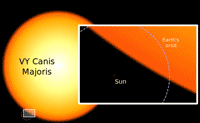
Canis Major (大犬座; dàquǎn zuò); CMa
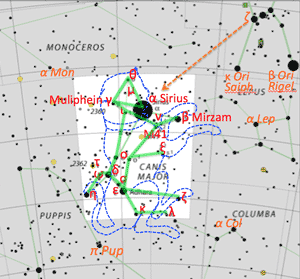
>Top <Canis Minor, CMi>
- ★α CMi (Procyon); F-type, mag. 0.34, 7th brightest stay in the sky, as well as one of the closest 11.46 ly; 1.50 M⦿, 2.05 R⦿, 6.93 L⦿.
- β CMi (Gomeisa); B-type, mag. 2.89 at 162 ly; 3.5 M⦿, 3.5 R⦿, 195 L⦿.
- Procyon and Gomeisa were called twins in 1100BC.
- The Greeks call the constellation Procyon, 'coming before the dog'.
- In Greek mythology, CMi was sometimes connected with Teumessian Fox, a beast turned into stone with its hunter Laelaps by Zeus, who laced them in heaven as Canis Major (Laelaps) and Canis Minor (Teumessian Fox).
Canis Minor (小犬座; xiǎoquǎn zuò); CMi
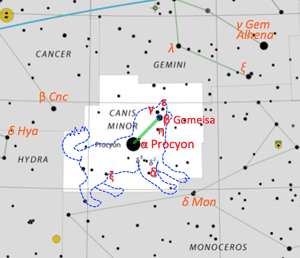
>Top <Capricornus, Cap>
- α1 Cap (Algedi), G-type, mag 4.27 at 570 ly; 5.3 M⦿, 1047 L⦿.
- α2 Cap; G-type, mag 3.58 at 109 ly.
- β Cap (Dabih); K/B-type double star, mag 3.05 at 328 ly.
- γ Cap (Nashira), kF-type, mag 3.67 at 139 ly.
- δ Cap (Deneb Algedi) (<tail of goat); A-type brightest star, mag 2.81 Mv 2.46 at 39 ly; 2.0 M⦿, 1.91 R⦿.
- π Cap; B-type double star, mag 8.3 at 670 ly.
- M30 centrally condensed globular cluster, mag. 7.5 and 30K ly.
- In Greek mythology, identified as Amalthea, the goat that suckled the infant Zeus after his mother, Rhea, saved him from being devoured by his father Cronos. The goat's broken horn was transformed into the cornucopia or horn of plenty.
- Capricornus is also identified as Pan, the god of goat's head, who saved himself from the monster Tyhon by giving himself a fish's tail and diving into a river.
Capricornus (山羊座; 摩羯座 mójié zuò); Cap
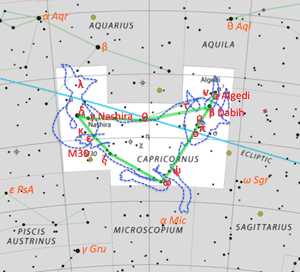
>Top <Carina, Car>
- ★α Car (Canopus); A-type supergiant the second brightest star in the sky, mag -0.72 Mv -5.71 at 313 ly.
- ☆β Car (Miaplacidus); A-type mag 1.69 Mv -1.01 at 113 ly.
- ☆ε Car (Avior); K-type orange giant, mag 1.86 at 630 ly.
- θ Car, mag 2.7 at 440 ly.
- ☆ι Car (Aspidiske); A-type white supergiant A-type, mag 2.21 Mv -5.1 at 690 ly.
- η Car; mag 4.5, binary with combined luminosity over 5M of ⦿ at 7500 ly away. The two main stars have an eccentric orbit with 5.54 y period; primary 150-250 M⦿, which is expected to explode as a supernova near future; secondary star is hot (class O), 30-80 M⦿.
- ω Car (Avior); K/B-type mag 1.86 Mv -1.98 at 342 ly.
- False Cross: consists of ι Car, ε Car, κ Vel, and δ Vel
- Carina is Latin for 'the keel of a ship', once a part of constellation of Argo Navis. Nicolas Louis de Laically divided Argo into three components in 1783, including Carina, Puppies (poop deck), and Vela (sails of the ship)
- Canopus came from mythological Canopus, a navigator for Menelaus, king of Sparta.
- η Car:
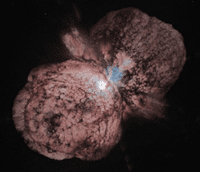
Carina (竜骨座; 船底座 chuándǐ zuò); Car
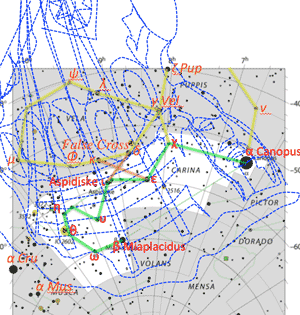
>Top <Cassiopeia, Cas>
- W asterism. W when below Polaris during spring-summer nights. In winter, W appears inverted.
- ☆α Cas (Schedar); <Ar. Al Sadr, breast, K-type brightest, a multiple star; mag. 2.24 Mv -1.98 at 230 ly. Is luminosity is 771 of ⦿.
- ☆β Cas (Caph); <hand; F-type, mag 2.25-2.31 Mv 1.3 at 54 ly, 1.9 of M⦿, 3.43 R⦿.
- ☆γ Cas; B-type variable binary, mag 2.47 (1.6-3.0) Mv -3.98 at 550 ly.
- δ Cas; Rukbat (<kee); A-type Algol-type eclipsing binary, mag 2.7 at 99 ly.
- ε Cas; B-type mag 3.3 at 410 ly, 6.5 time of ⦿.
- η Cas; G-type mag 3.5 at 19 ly.
- ζ Cas; B-type mag 3.7 at 597 ly.
- κ Cas; B-type mag 4.2 Mv -6.34 at 4127 ly.
- ρ Cas; G-type mag 4.5 Mv -9.5 at 8200 ly; 14-30 M⦿, 400-500 R⦿, 500,000 L⦿. <Fig>
- Cassiopeia, queen of Aethiopia, was wife of King Cepheus of Aethiopia and mother of Andromeda, enraging Poseidon with the boast that her daughter was more beautiful than Nereids. She was forced to wheel around the North Pole on her throne, so she does not fall off.
- <Fig> Big stars: Pistol Star (340 R⦿), ρ Cas (450 R⦿), Betelgeuse (1000 R⦿), VY CMa (1420 R⦿)
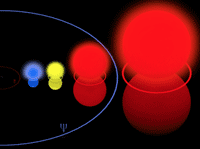
Cassiopeia (カシオペア座; 仙后座 xiānhòu zuò); Cas
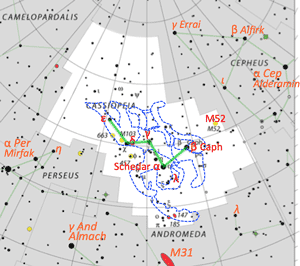
>Top <Centaurus, Cen>
- A bright constellation in the southern sky.
- ★α Cen (Rigil Kentaurus or Toliman), 'foot of the centaur'; G-type mag. -0.28, Mv 4.25 the nearest star system 4.4 ly to ⦿,Gome has a high proper motion; a triple star system; the primary mag. -0.01 and the secondary is mag 1.35, and the tertiary is a red dwarf of mag 11.0; Cf. "Three suns of Centaurus"
- ★β Cen (Hadar and Agena); a double star; primary B-type mag 0.61 Mv -4.53 at 390 ly, 11 M⦿, and 42 L⦿, and the secondary if mag 4.0.
- ☆γ Cen; A-type bright binary mag 2.17 Mv -0.81 at 130 ly.
- ☆ε Cen; B-type variable mag 2.29-2.31 Mv -3.9 at 380 ly.
- ☆η Cen; B-type variable mag 2.30-2.41 at 310 ly.
- ω Cen, B-type;
or NGC5139
the brightest known globular cluster in the Milky Way, 17000 ly with a diameter 150 ly.
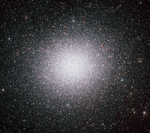
- ☆θ Cen (Menkent); K-type mag 2.06 at 61 ly.
- ☆η Cen; B-type mag 2.35 at 310 ly.
- BPM37093 is a white dwarf, whose carbon atoms are though to have formed a crystalline, diamond?, nicknamed 'Lucy' after the Beatles son 'Lucy in the Sky with Diamonds.'
- While Centaurus now has a high southern latitude, at the dawn of civilization it was an equatorial constellation. Precession has been slowly shifting it southward for millennia. Thousands of year from now Centaurus will once again be a lower latitudes and be visible worldwide.
- In Greek mythology, Centaurus represents a centaur; a creature of half human & half horse.
- The southern Cross is now regarded as a separate constellation, was treated as a mere asterism composing the Centaur's legs.
Centaurus (ケンタルス座; 半人马座 bànrénmǎ zuò); Cen
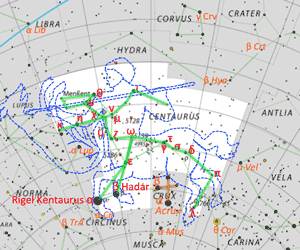
<Centaurus-Crux>:
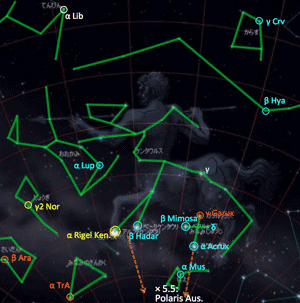
>Top <Cepheus, Cep>
- α Cep (Alderamin), A-type brightest star with mag 2.46 at 49 ly, 1.7 M⦿, 2.46 R⦿. 17 L⦿.
- β Cep (Alfirk); B-type mag 3.23 at 685 ly.
- γ Cep; K-type mag 3.22 at 45 ly; will be the polar star around 3100, and β Cep will be it around 5100, then α Cep around 7500.
- δ Cep (DCEP, Population I); F-type, the prototype of an important class of star known as a Cepheid variable, mag. 3.5-4.4. over 5.366 days at 887 ly, with 40-46 M⦿, double star. (1M⦿=2×10^30kg)
- ε Cep; F-type mag 4.18 at 84 ly.
- θ Cep; A-type mag 4.21 at 136 ly.
- ζ Cep; K-type mag 3.35 at 726 ly.
- ι Cep: K-type mag 3.50 at 115 ly; will be the north pole star around 5200AD.
- η Cep; K-type mag 3.41 at 47 ly.
- μ Cep; M-type mag 4.04 known as Herschel's Garnet Star due to its deep red color, 11.8 AU in radius.
- ν Cep; A-type mag 4.25 Mv -6.72 at 5094 ly.
- RW Cephei, Mu Cephei, VV Cephei and V354 Cephei are red supergiant among the largest stars known; RW Cep 1535, V354 Cep 1520 R⦿. (1R=696K km)
- Quasar S5 0014+81, hosting most massive black hole known, 40B M⦿, about 10K times more massive than the central black hole of the Milky Way.
- It was named after Cepheus, King of Aethiopia in Greek mythology, married to Cassiopeia and farther of Andromeda; both represented by neighboring constellations.
Cepheus (ケフェウス座; 仙王座 xiānwáng zuò); Cep
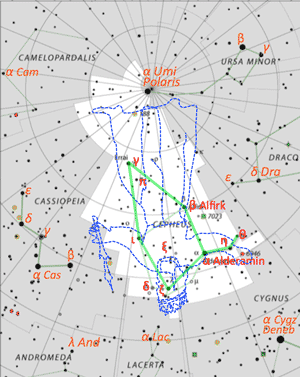
>Top <Cetus, Cet>
- α Cet (Menkar); 'the nose' is a red giant double star of mag 2.5 at 220 ly.
- ☆β Cet (Deneb Kaitos, Diphda);'the whale's tail', K-type brightest, mag 2.02 at 96 ly.
- γ Cet (Kaffaljidhma); 'head of the whale' , mag 3.5 at 82 ly.
- τ Cet; is noted for being the nearest Sun-like star at 12 ly.
- ο Cet (Mira); 'the wonderful' was the first variable star; it reaches a max mag 3 to dip to min 10. Mira pulsates 400-500 R⦿ at 420 ly.
- M77; 9th magnitude spiral galaxy near δ Cet, mag 10 at 50M ly.
- Cetus may have originally been associated with a whale, which would have had mythic status amongst Mesopotamian cultures. Now it is called the Whale, though it is most strongly associated with the sea-monster, who was slain by Perseus as he saved the princess Andromeda from Poseidon's wrath. Cetus is located in a region of the Sky Sea, because may water-associated constellations are placed there, including Eridanus, Pisces, Piscis Austrinus, Capricornus, and Aquarius.
- In 17C, Cetus was depicted as a 'dragon fish', or a whale-like creature; it has also been depicted with animal head attached to a piscine body.
- Mira was discovered by David Fabricius in 1596.
Cetus (鯨座; 鲸鱼座 jīngyú zuò); Cet
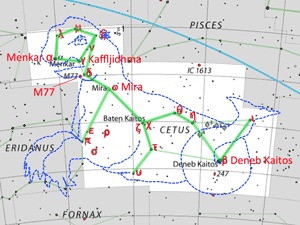
>Top <Chamaeleon, Cha>
- Chamaeleon is a small constellation in the southern sky. It was firs defined in 16C.
- α Cha is the brightest F-type white-hued star of mag 4.1, with 63 ly.
- β Cha is a blue-white B-type star of mag 4.2, with 27 ly .
- γ Cha is a red M-type giant star of mag 4.1, 413 ly.
- δ2 Cha is B-type double star, mag 4.4, and 364 ly away.
- Chamaeleon was one of 12 constellations created by Petrus Plancius. It first appeared on a 35cm diameter celestial globe published in 1597. It was one of many constellations created by European explorers in 15-16C out of unfamiliar Souther Hemisphere stars.
Chamaeleon (カメレオン座; 蝘蜓座 yǎntíng zuò); Cha
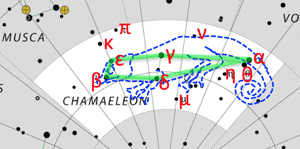
>Top <Circinus, Cir>
- α Cir, the brightest star, mag 3.19.
It is a small, faint constellation in the southern sky, first defined in 1756 by French astronomer Nicolas-Louis de Lacaille. Its name is Latin for compass, a drafting tool for drawing circles.
Circinus (コンパス座; 圆规座 yuánguī zuò); Cir
>Top <Columba, Col>
- α Col (Phact), means 'ring dove', the brightest of mag 2.7, a ble-white star.
- β Col (Waz) an orange-hued gaint star mag 3.1, at 86 yt.
- Antapec: ⦿ is moving away from the direction of Columba.
- A small, faint constellation created Petrus Placius in 1592 with its name Latin for 'dove', to diffrentialte the unformed stars of Canis Major.
- Originally named Columba Noachi ('Noah's Dove'), referring to the dove that gave Noah the information that the Great Flod was receding. Columba may also represent the dove released by Jason and the Argonauts at the Black Sea, which helped them navigate the dangerous Symplegades.
Columba (鳩座; 天鸽座 tiāngē zuò); Col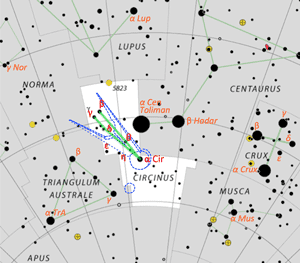
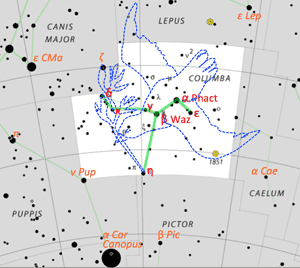
>Top <Coma Berenices, Com>
- α Com (Diadem), mag 4.3.
- β Com, the brightest, mag 4.2 main sequence star similar to ⦿ at about 30 ly; if to observer ⦿ from this place, ⦿ shines just like this β Com.
- γ Com, binary, mag 4.4
- Coma Cluster; contains the North Galactic Pole, one of the richest known galaxy clusters.
- Closest star-forming region: Corona Australis Molecular Cloud, 430 ly.
- The court astronomer Conon of Egyptian rule Ptolemy III Euergetes, to honor Ptolemy's consort, Berenice II. Verenice vowed to sacrifice her long hair as a votive offering if Ptolemy returned safely from battle during the Third Syrian War (243BC).
- She dedicated her tresses to Aphrodite and placed them in the temple of Arisinoe II. By the next morning, the tresses had disappeared. Conon proposed that Aphrodite had placed the tresses in the sky as an acknowledgement of Berenice's sacrifice.
Coma Berenices (髪座; 后发座 hòufà zuò); Com
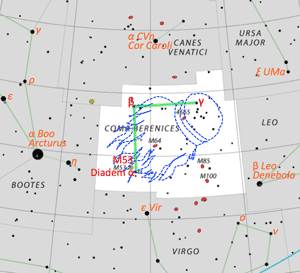
>Top <Corona Austrina, CrA>
- α CrA (Meridiana), the brightest, mag 4.10 at 130 ly.
- β CrA, orange giant, mag 4.11 at 510 ly, 43 R⦿, 4.5 M⦿, and 730 L⦿.
- γ CrA, binary, at 58 ly.
- ε CrA known as contact binaries, varying mag 4.83 every 7 hours. <Fig>

- It is southern counterpart of Corona Borealis, listed by 2C astronomer Ptolemy. The ancient Greeks saw Corona Australis as a wreath rather than a crown.
- Other cultures have linked the pattern to a turtle, ostrich nest, a tent, or even a hut belonging to a rock hyrax.
Corona Austrina (南の冠座; 南冕座 nánmiǎn zuò); CrA
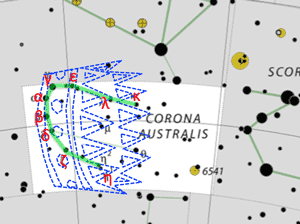
>Top <Corona Borealis, CrB>
- The seven stars that make up distinctive crown-shaped constellation. It has a counterpart - Corona Australis.
- ☆α CrB (Alphecca), brightest A-type variable, mag 2.21-2.32 at 75 ly, Algo-type eclipsing binary with a period of 17.4 days., 2.91 M⦿, 57 L⦿.
- β CrB (Nusakan), binary, mag 4.13, 2.1 M⦿, 2.6 R⦿, 25.3 L⦿.
- θ CrB, binary, mag 4.13, at 380 ly.; θ CrB-A spins extremely rapidly at 393 km/s, Be star surrounded by a debris disk.
- In Greek mythology, it was linked to the legend of Theseus and the minotaur.
- The besotted Dionysus give the crown to Ariadne, the daughter of Minos of Crete, who in turn gives it to Theseus after he arrives in Crete to kill the minotaur that the Cretans have demanded tribute from Athens to feed. The hero used the crown's light to escape the labyrinth after disposing of the creature, and Dionysus later sets it in the heaven.
Corona Borealis (冠座; 北冕座 běimiǎn zuò); CrB
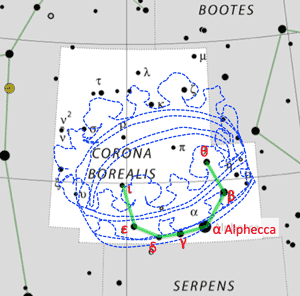
>Top <Corvus, Crv>
- α Crv (Alchiba), binary, a white-hued star, mag 4.0, at 49 ly.
- β Crv, and δ, γ, ε Crv form a quadrilateral asterism known as the Spica's Spanker or the Sail. γ and δ serve as pointers toward Spica.
- γ Crv (Gienah), the brightest B-type star, mg 2.59, at 154 ly, 4.2 M⦿, and 255 L⦿.
- Antennae Galaies (NGC4038/4039) a par of interacting galaxies <Fig.>
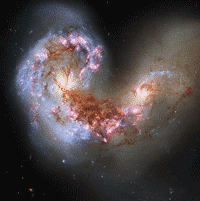
- Corvus is associated with the myth of Apollo and his lover Coronis the Lapth. Coronis had been unfaithful to Apollo; when he learned this from a pure white crow, he turned its feathers black in a fit of rage.
- Another legend associated with Corvus is that crow stopped on his way to fetch water for Apollo, to eat figs. He lied and said that a snake, Hydra, kept him from the water, while holding a snake in his talons as proof. Apollo, realizing this was a lie, flung the crow, cup, and snake into the sky. He further punished the wayward bird by ensuring it would forever be thirsty, both in real life and in the heaves, where the Cup is just out of reach.
Corvus (烏座; 乌鸦座 wūyā zuò); Crv
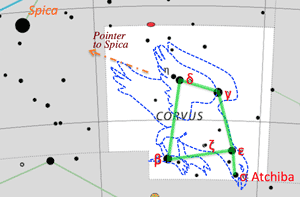
>Top <Crater, Crt>
- The brighter α, γ, δ Crt form a triangel.
- α Crt is an orange-hued star mag 4.1, at 159 ly, with 1.6 M⦿, has exhausteed its core H and expanded to 12 R⦿, shining 69 L⦿.
- β Crt is binary, mag 4.5, at 266 ly.
- δ Crt is the brightest, mag 3.56 at 186 ly away; an orange giant star1-1.4 M⦿.
- In Greek mythology, a crow or raven serves Apollo, and sent to fetch water, but it rests lazily on the journey, and after finally obtaining the water in a cup, takes back a water snake as an excuse. Apollo saw through the fraud, and angrily cast the crow, cup, and snake, into the sky.
Crater (コップ座; 巨爵座 jùjué zuò); Crt
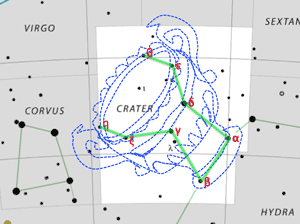
>Top <Crux, Cru>
- This is commonly used to mark south, tracing a line from Gacrux to Acrux leads (4.5 times) near to the Southern Celestial Pole. Alternatively, a line perpendicular between α Cen and β Cen, the point where the above line and this line intersect marks the Pole.
- The asterism are α, β, γ, δ Cru.
- ★α Cru (Acrux) the brightest, a triple star 321 ly. blue-tinged B-type; mag 0.8, and mag 1.3 and 1.8; the southernmost first magnitude star; 15 M⦿, 16000 L⦿.
- ★β Cru (Mimosa); B-type blue-hued Cepheid variable B-type, mag. 1.3, at 353 ly, 1.3 M⦿.
- ☆γ Cru (Gacrux) M-type red giant, the nearest ⦿, mag 1.64 at 88 ly, the 3rd brightest star in southern sky.
- δ Cru, blue-white B-type mag 2.8 at 364 ly.
- NGC 4755; colorful open cluster known as 'the Jewel Box.'
- Dark nebula; known as 'the Coalsack Nebula'
- It can be seen from southern Egypt; Ptolemy regarded it as part of constellation Centaurus. It was entirely visible as far north as UK in 4th millennium BC. However the precession gradually lowered its stars below the horizon.
- João Faras, astronomer of King Manuel I of Portugal who accompanied Pedro Álvares Cabral in the discovery of Brazil in 1500 to depict it correctly. Amerigo Vespucci seems to have observed on his second voyage n 1501-02.
- Crux is kite-shaped (Latin cross) and has fifth star (ε Cru). But nearby 'False Cross' is diamond-shaped (Greek cross), somewhat dimmer does not have a fifth star and lacks two prominent Pointer Stars.
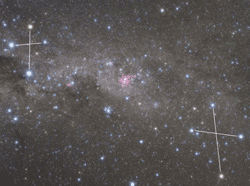
Crux (南十字座; nánshízì zuò); Cru
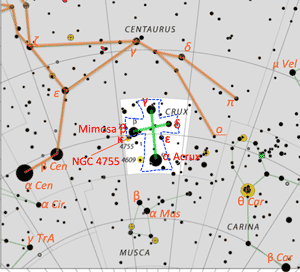
>Top <Cygnus, Cyg>
- ★α Cyg (Deneb) A-type brightest, a white supergiant, mag 1.21-1.29 Mv -8.38 at 1550 ly, 19 M⦿, 203 R⦿, and 196K L⦿.
- β1 Cyg (Albireo), K-type binary star, mag. 3.05 at 385 ly.
- ☆γ Cyg (Sadr, 'breast'); F-type, mag 2.23 Mv -6.12 at 1523 ly.
- δ Cyg, B-type mag 2.86 at 171 ly.
- ☆ε Cyg; K-type, mag 2.48 at 72 ly.
- ζ Cyg; G-type mag 3.21 at 151 ly.
- ξ Cyg; K-type mag 3.72 Mv -4.07 at 1177 ly
- η Cyg: K-type mag 3.89 Mv 0.74 at 139 ly; the first X-ray source Cygnus X-1 believed to be a black hole.
- σ Cyg; B-type mag 4.22 Mv -6.49 at 4528 ly.
- κ Cyg; G-type mag 3.80 at 124 ly.
- ι Cyg; A-type mag 3.76 at 122 ly.
- In Greek mythology, Zeus disguised himself as a swan to seduce Leda, Spartan King Tyndareus's wife, who gave birth to Pollux of Gemini, Helen of Troy and Clytemnestra; Orpheus was transformed into a swan after his murder, and was said to have been placed in the sky next to his lyre (Lyra).
- Phaethon, son of Helios the sun god, who demanded to ride his father's sun chariot for a day. Phaethon was unable to control the reins, forcing Zeus to destroy the chariot and Phaethon with a thunder bolt, causing it to plummet to the earth into the river Eridanus.
Cygnus (白鳥座; 天鹅座 tiān'é zuò)
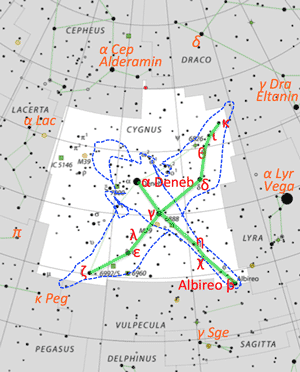
>Top <Delphinus, Del>:
- Its name is Latin for dolphin.
- α Del (Sualocin), blue-white B-type main sequence star of mag 3.77 at 241 ly.
- β Del (Rotanev), brightest F-type binary, mag 3.63 at 97 ly.
- γ Del, F-type binary star, mag 5.14 at 102 ly.
- δ Del, A-type, mag 4.43
- ε Del (Dulfim), B-type, 'tail of the Dolphin', mag 4.
- Rhombus of α, β, γ, δ stars is called 'Job's Cofin'.
- God Poseidon wanted to marry Amphoteric, beautiful Nereid. She, wanting to protect her virginity, fled to the Atlas mountains. Delphinus accidentally stumbled upon her and was able to persuade Amphoteric to accept Poseidon's wooing. Out of gratitude the god placed the image of a dolphin among the stars.
- The second story tells of the Greek poet Arion of Lesbos who was saved by a dolphin. On his way from Tarentum his wealth caused the crew of his ship to conspire against him. Threatened with death, Arion asked to be granted a last wish: he wanted to sing a dirge. This he did, flung himself into the sea. There, he was rescued by a dolphin which had been charmed by Arion's music. The dolphin carried Arion to the coast of Greece and left.
Delphinus (海豚座; hǎitún zuò); Del
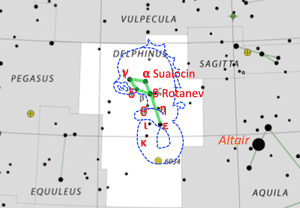
>Top <Dorado, Dor>
- α Dor, the brightest star, mag 33, at 176 ly.
- β Dor, bright Cepheid variable, mag 3.5-4.1, at 1040 ly
- Suprnova 1987A was the closest supernova to occur since invention of telescope.
- Rich in deep sky objects.
- The Large Magellanic Cloud, a satellite galaxy of the Milky Way, at 179K ly.
- NGC 1566 is a face-on spiral galaxy. <Fig>
- Even though the name Dorado is not Latin but Portuguese; it is treated as a feminine proper name of Greek origin ending in -o (like Io or Callisto or Argo).
- It first appeared on a celestial globe published in 1597. Dorado has been represented historically as a dolphinfish and swordfish.
- <Fig> NGC 1566:
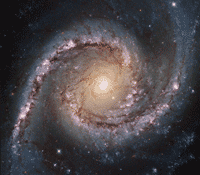
Dorado (旗魚座; 剑鱼座 jiànyú zuò); Dor
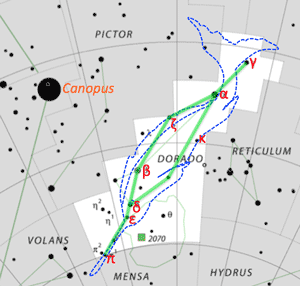
>Top <Draco, Dra>
- α Dra (Thuban), A-type; meaning 'head of the serpent', was the norther pole star from 3942BC until 1793BC. Egyptian Pyramids were designed to have one side facing north, geometrically aligned that Thuban would be visible at night. Dut to its precession, it will again be the pole star around 21000AD; mag 3.7 at 309 ly.
- β Dra (Rastaban), G-type yellow giant mag 2.8 at 362 ly.
- ☆γ Dra (Eltanin), K-type brightest orange giant, meaning 'head of the serpent', mag 2.23 at 150 ly.
- δ Dra; G-type mag 3.1 at 100 ly.
- ζ Dra; B-type mag 3.2 at 340 ly.
- ι Dra; K-type mag 3.3 at 102 ly.
- η Dra, G-type double, mag 2.8 at 88 ly.
- NGC 6543, a bright planetary nebula; Cat's Eye Nebula, discovered by William Herschel in 1786. <Fig>
- In Greek mythology, the dragon who guarded the golden apples of the Hesperides. Hercules killed Ladon during his 12 labors; he was tasked with stealing the golden apples. The constellation of Hercules is depicted near Draco.
- In Greco-Roman legend, Draco was a dragon killed by goddess Minerva and tossed into the sky. As Minerva threw the dragon, it became twisted on itself and froze at the cold North celestial Pole before it could right itself.
- <Fig> Cat's Eye Nebula:
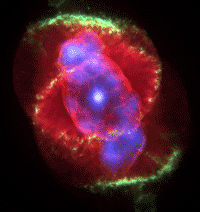
Draco (竜座; 天龙座 tiānlóng zuò); Dra
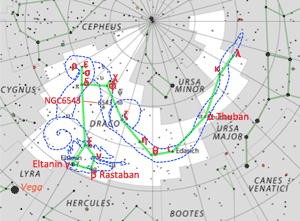
>Top <Equuleus, Equ>:
- α Equ (Kitalpha), the brightest, meaning 'section of the horse', yellow star mag 3.9, at 186 ly.
- β
- γ Equ, variable mag 4.6-4.8 over 12.5 min.
- In Greek mythology, Equuleus with the foal Celeris ('speed'), who was the offspring or brother of the winged horse Pegasus. Celeris was given to Castor by Mercury.
- Other myths say that Equuleus is the horse struck from Poseidon's trident during the contest between him and Athena when deciding which would be the superior. Because this section of stars rises before Pegasus, it is often called Equus Primus ('First Horse').
Equuleus (小馬座; 小马座 xiǎomǎ zuò); Equ
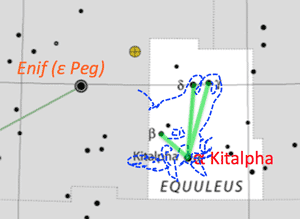
>Top <Eridanus, Eri>
- ★α Eri (Achernar); brightest blue-white hued brightest star, meaing 'the river's end', B-type mag 0.46 at 139 ly; very peculiar because one of the flattest stars known. 50% larger at the equator than at the poles. 7.3-11.4 R⦿, 6.7 M ⦿, and 3150 L⦿. <Fig>
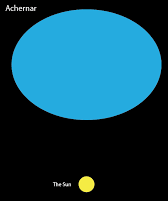
- β Eri (Cursa), bule-white mag 2.8, at 89 ly.
- θ Eri (Acamar), binary blue-white mag 4.8 at 161 ly.
- ε Eri, have an extrasolar planet of 1 Jupiter mass, period of 7 years.
- The name Eridanus refers to the Po River of Italy.
- Eridanus is depicted as a river flowing from the waters poured by Aquarius.
- Eridanus is connected to the myth of Phaethon, who took over the reins of his father Holies' sky chariot (=Sun), but didn't have the strength to control it, scorching both Earth and heaven. Zeus intervened by striking Phaethon dead with a thunderbolt and casting him to Earth. The constellation was supposed to be the path Phaethon drove along; in later times, it was considered a path of souls.
Eridanus (エリダヌス座; 波江座 bōjiāng zuò); Eri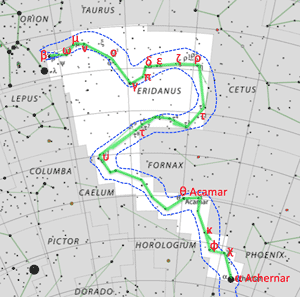
>Top <Fornax, For>:
- α For, brightest, binary, mag 3.9, with 1.2 M⦿, and 1.9 R⦿.
- β For is yellow-hued giant star, mag 4.5, swell to 11 R⦿, at 169 ly.
Fornax (炉座; 天炉座 tiānlú zuò); For
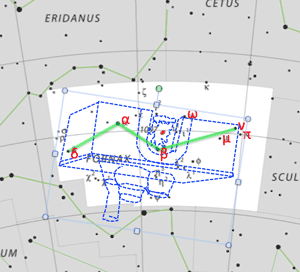
>Top <Gemini, Gem>:
- Gemini is one of zodian costellations.
- ☆α Gem (Castor) A-type blue-white binary mag 1.62 at 52 ly.
- ★β Gem (Pollux) K-type brightest orange-hued giant star mag 1.2 at 34 ly, 2 M⦿, 8.8 R⦿, and 43 L⦿.
- ☆γ Gem (Alhena) A-type mag 1.92 at 100 ly.
- δ Gem (Wasat)
- M35 is a large, elongated open cluster with 200 stars.
- Medusa Nebula is a planetary nebural, 1500 ly.
- Geminids meteor shower peaks on Dec.13-14.
- In Greek mythology, Pollux was the son of Zeus, who seduced Leda disguised himself as a swan, while Castor was the son of Tyndareus, king of Sparta and Leda's husband. When Castor died, because he was mortal, Pollux begged his farther Zeus to give Castor immortality by uniting them together in the heavens.
- Helen of Troy was a sister of Castor & Pollux.
Gemini (双子座; shuāngzi zuò); Gem
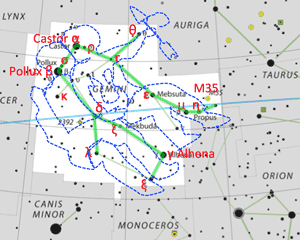
>Top <Grus, Gru>
- ☆α Gru (Alnair); B-type blue-white star, mag 1.74 at 100 ly.
- ☆β Gru; M-type red giant M-type variable, mag 2.0-2.3 at 170 ly.
- Its name is Latin for 'crane'; published in 1598.
- The constellations Grus, Pavo, Phoenix and Tucana are collectively known as the 'Southern Birds.
Grus (鶴座; 天鶴座 tiānhè zuò); Gru
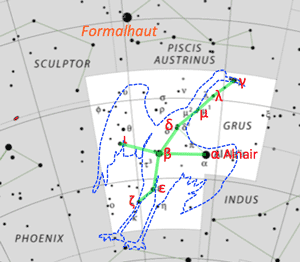
>Top <Hercules, Her>:
- α Her (Rasalgeth), M-type triple, mag 3.31 at 382 y.
- β Her (Kornephoros), 'club-bearer', G-type brightest yellow giant, mag 2.8 at 148 ly.
- δ Her (Sarin), A-type binary, mag 3.8 at 195 ly.
- ζ Her; F-type bianary, mag 2.9 at 35 ly
- π Her; K-type mag 3.16 at 367 ly.
- ι Her; B-type mag 3.82 at 495 ly.
- η Her; G-type mag 3.48 at 112 ly.
- τ Her; B-type mag 3.91 at 314 ly.
- Hercules was the greatest hero in mythology; he was the son of Zeus and Alcmena. Hera was unhappy with Zeus' infidelity. She delayed his birth, and when Hercules was a mere baby sent two snakes into the crib he shared with his mortal half-twin Ihicles. Hercules killed them both with his bare hands. After grew up he married Princess Megara, daughter of the king Thebes. Hera succeeded in driving him mad and he killed his wife and children. As atonement, He serves to perform 12 labors for which he is most famed.
- The constellation found between Lyra and Bootes, shows the here wearing the skin of the Nemean Lion while holding his characteristic club and Cerberus the three-headed dog. He also rests his foot atop the head of Draco the dragon.
Hercules (ヘルクレス座; 武仙座 wǔ xiān zuò); Her
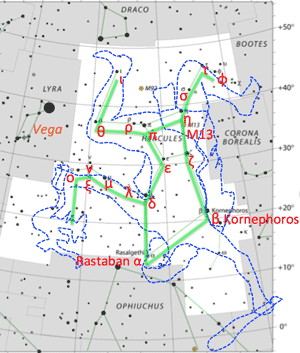
>Top <Horologium, Hor>
- α Hor, brightest, orange giant, mag 3.9, at 115 ly.
- β Hor white giant, mag 5.0, at 314 ly.
- λ Hor yellow-white giant F2, at 161 ly.
- French astronomer Nicholas Louis de Lacaille described a clock with pendulum and seconds hand in 1752. He devised 14 new constellations in uncharted regions of the Southern Celestial Hemisphere not visible from Europe.
Horologium (時計座; 时钟座 shízhōng zuò); Hor
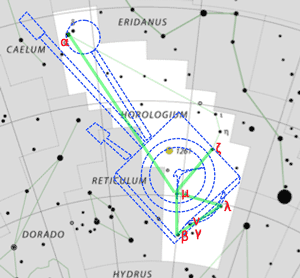
>Top <Hydra, Hya>
- ☆α Hya (Alphard); K-type brightest orange giant mag 2.00 at 180 ly.
- β Hya, B-type blue-white, mag 4.3 at 365 ly.
- γ Hya, yellow giant mag 3.0 at 132 ly.
- R Hya, Mira variable star mag 3.5-10 a period of 390 days at 2000 ly away.
- Hydra is the largest of 88 constellations. It has a long history, among 48 constellations.
- The shape of Hydra resembles a twisting snake. One myth associates it with a water snake that a crow served Apollo in a cup when it was sent to fetch water; Apollo saw through the fraud, and angrily cast crow, cup, and snake, into the sky.
- It is also associated with the monster Hydra, with its many heads, killed by Hercules; if one of the hydra's heads was cut off, two more would grow in its place. However, Hercules burned out the roots of the heads her severed to prevent them for growing again, and thus overcame the hydra.
Hydra (海蛇座; 长蛇座 chángshézuò zuò); Hya
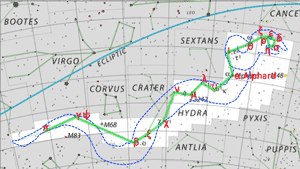
>Top <Hydrus, Hyi>
- α Hyi (Alpphard), 'the solitary one', 2nd F-type brightest star, mag 2.86, at 177 ly.
- β Hyi; G-type brightest yellow supergiant, mag 2.79, at 24 ly; having 1.04 M⦿ and 1.8 R⦿, but 3 L⦿, slightly more evolved star than ⦿, H fuel exhausted at its core. It is the nearest subgiant star to ⦿. This star 6.4-7.1B years old, considered as the future of ⦿. It is located just southwest of Achernar of α Eri.
- A line drawn between α Hyi and β Cen is bisected by the south celestial pole.
- γ Hyi; M-type red giant mag 3.3, at 214 ly, around 1.5-2 M⦿ and has expanded to 60 of R⦿, shines 655 L⦿.
- δ Hyi; A-type mag 4.08 at 135 ly.
- ζ Hyi; A-type mag 4.83 at 295 ly.
- μ Hyi; G-type mag 5.27 at 292 ly.
- HD10180, has 7 and possibly 2 more planets, mag 7.33 at 127 ly.
- GJ3021 is a solar twin (G8V), mag 6.7 at 57 ly, having a 3.37 Jovian planet orbiting about 0.5AU from its sun in 133 days.
- A small constellation in deep souther sky publshed in 1597. Its name means 'male water snake, as opposed to Hydra, a much larger constellation that represents a 'female water snake'.
Hydrus (水蛇座; shuǐshé zuò)
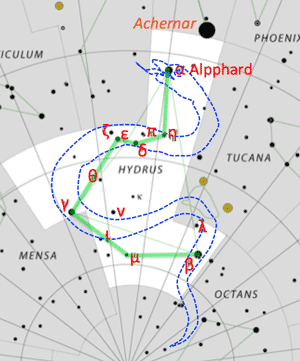
>Top <Indus, Ind>:
- α Ind, brightest orange giant, mag 3.1 at 101 ly.
- β Ind organge giant, mag 3.7 at 600 ly.
- γ
- δ Ind whit star, mag 4.4 at 185 ly.
- ε Ind, one of the closest orange dwarf mag 4.7 at 12 ly; slightly hotter and larger than ⦿, has long been a prime candidate in SETI studies.
Indus (インディアン座; 印第安座 yìndìān zuò); Ind
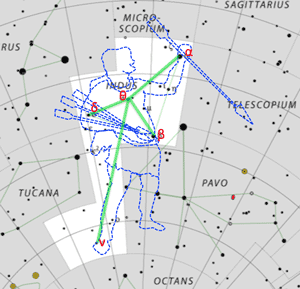
>Top <J>:
>Top <K>:
>Top <Lacerta, Lac>:
- α Lac, brightest blue-white binary mag 3.8 at 102 ly.
- β Lac, yellow giant mag 4.4 at 170 ly.
- EV Lac, rapidly spinning mag 10 red dwarf with a strong magnetic fiels; a flare star, thousands of more energetic than ⦿.
- BL Lac is the prototype of BL Lacertae objects, apper to be dim variable stars but actually variable nuclei of elliptical galaxies; they are similar to quasars, mag 14-17.
Lacerta (蜥蜴座; 蝎虎座 xiēhǔ zuò); Lac
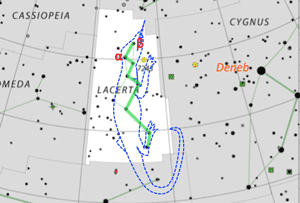
>Top <Leo, Leo>
- ★α Leo (Regulus); B-type brightest blue-white sta, mag 1.34, 77 ly, is a double star, 3.8 M⦿, 3.1 R⦿, 288 L⦿.
- ☆β Leo (Denebola, lion's tail); A-type blue-white, mag 2.11 at 36 ly.
- ☆γ1 Leo (Algieba); K/G type binary star , mag 2.08 at 130 ly.
- Meteor showers: Leonids occur peaking Nov. 14-15, have a radian close to γ Leo.
- In Greek mythology, Leo was identified as the Nemean Lion which was killed by Heracles during the first of his 12 labors. The Lion was impervious to any weaponry; When the Lion pounced, Hercules caught it in midair, one hand grasping the Lion's forelegs and the other its hi legs, and bent it backwards, breaking it back and freeing the trapped maidens.
Leo (獅子座; shīzi zuò); Leo

>Top <Leo Minor, LMi>
- β LMi; G/F-type, the second-brightest binary mag 4.40 at 146 ly; 2 M⦿, 7.8 R⦿, 36 L⦿.
- 46 LMi; K-type brightest orange giant, mag 3.8, at 95 ly; 1.69 M⦿, 8.22 R⦿, 34 L⦿.; It was pesumably inteded to be desginated α, but the designation was missing from Francis Baily's catalogue, even though the dimmer β was included.
- 21 LMi; A-type mag 4.49 at 92 ly; a rapidly rotating white star; 1.6 M⦿, 10 L⦿.
- Hanny's Voorwerp; quasar ioniation echo, discovered in 2007, appears a bright blob close to spiral galaxy IC2497. <Fig>
- Its name is Latin for 'the smaller lion', in contrast to Leo. Leo Minor was not regarded as a separete constellationp; it was designated by Johannes Hevelius in 1687.
- <Fig> Hanny's Voorwerp; Quasar ioniation echo:
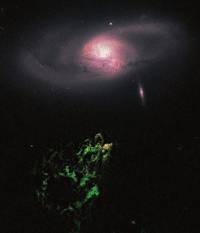
Leo Minor (小獅子座; 小狮座 xiǎoshī zuò); LMi
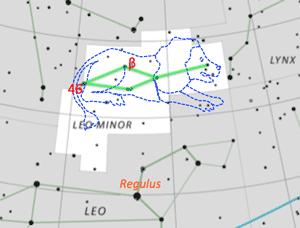
>Top <Lepus, Lep>
- α Lep (Arneb), 'hare', the brightest white supergiant mag 2.6 at 1300 ly.
- β Lep (Nihal),yellow giant mag 2.8, at 159 ly
- γ Lep binary, mag 3.6 at 29 ly.
- Lepus is most often represented as a rabbit being hunted by Orion and whose hunting dogs pursue it.
- The constellation is associated with some lunar mythology, including the Moon rabbit.
- Four stars of this constellation (α, β, γ, δ Lep) form a quadrilateral known as 'Arsh al-Jawzā (the throne of Jawzā) and al-Nihāl, 'the Camels quenching their thirst'.
Lepus (兎座; 天兔座 tiāntù zuò); Lep
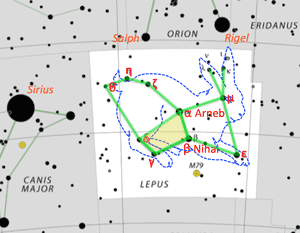
>Top <Libra, Lib>
- One of zodian constellations.
- α Lib (Zubenelgenubi); F-type, multiple star system, mag 2.8, at 75 ly.
- β Lib (Zubeneshamali); B-type brightest , mag 2.61, at 185 ly; 3.5 M⦿, 4.9 R⦿, 130 L⦿.
- γ Lib (Zubenelakrab), K-type, mag 3.91, at 152 ly; 2.2 M⦿, 71 L⦿.
- Gliese 581-c is considered the first Earth-like extrasola planet to be found within habitable zone.
- It is fairly faint, with no 1st mag. stars.
- The scales were held sacred to the sun god Samash, who was also the patron of truth and justice. (<Ar. zubānā, scorpion's claws); the sun entered this part of the ecliptic at the autumnal equinox, the days and nights are equal.
- It was also seen as the Scorpion's Claws n ancient Greece.
Libra (天秤座; tiānchèng zuò); Lib
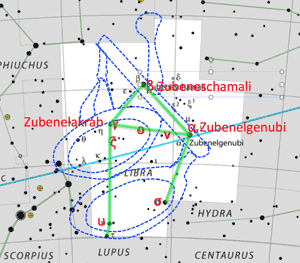
>Top <Lupus, Lup>
- ☆α Lup; B-type brightest ageing blue giant variable, mag 2.29-2.34 at 550 ly; It is a β Cephei variable, pulsating every 7hrs.
- GQ Lup; K-type, mag 11.40 at 500 ly; 0.7 M⦿.; having a companion GQ Lup-b, may be the first extrasola planet (1-36 Mj, separated 103 AU) directly imaged. <Fig>.
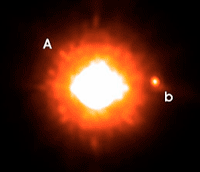
- NGC5882; planetary nebula.
- King Lycaon, who ruled Arcadia with his 5 sons. Zeus one day visited Arcadia disguised as a simple traveller. Lycaon and his osns offered him soup made not only from the meat of goats and sheep, but also of his own son Nyctimus. Zeus overthrew the table in disgust and killed all the king's sons with lightning bolts (restoring the life of Nyctimus in the process).
Lupus (狼座; 豺狼座 cháiláng zuò); Lup

>Top <Lynx, Lyn>
- α Lyn; K-type brightest orange giant mag 3.14 at 203 ly, 55 R⦿, 673 L⦿.
- Lynx is rich in double stars; such as 38 Lyn, 15 Lyn are binary; 12 Lyn is tripple.
- NGC2419; has hots three recent Type Ib supernovae.
- Polish astronomer Johannes Hevelius formed the constellation in 17C.
Lynx (山猫座; 天猫座 tiānmāo zuò); Lyn
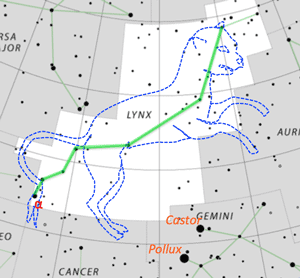
>Top <Lyra, Lyr>
- ★α Lyr (Vega); A-type brightest, mag 0.03 at 25 ly; 2.1M⦿, 2.3R⦿, 40.1L⦿.; name from Arabic al-wāqi (the falling eagle) ‹Fig› Comparison of Vega & Sun., From Vega, the Sun would appear 4.3 mag in Columba constellation.

- β Lyr (Sheliak); B-type, mag 3.52 at 960 ly, prototype of a class of stars as variables; 13 M⦿, 6 R⦿, 26300 L⦿. <Fig1>
- γ Lyr (Sulafat, 'turtle'); B-type, mag 3.25 at 620 ly.
- δ2 Lyr; M-type, mag 4.30 at 740 ly; 7.3 M⦿, 286 R⦿, 12900-23100 L⦿.
- ε Lyr; A-type, mag 4.59 at 162 ly; 'one of the most famous multiple star'; two sets of binary orbiting each other. A number of other nearby stars may be part of the system; bringing the system a total ten stars. <Fig2>
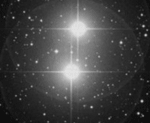
- ζ1 Lyr; A-type, mag 4.37 at 156 ly.
- M56; globular cluster, mag 8.3; 32900 ly with distance about 85 y.
- M57 known as Ring Nebula, diameter of 1 ly, 2000 ly, with mag. 8.8.
- In Greek mythology, Lyra represents the lyre of Orpheus. Mad by Hermes from a tortoise shell, given to Apollo as a bargain, it was the finest lyre ever produced. Orpheus's music was so great that even trees, streams, and rocks could be charmed.
- Orpheus married Eurydice, a nymph. While fleeing from an attack by Aristaeus, she stepped on a snake that bit her to kill. To reclaim her, Orpheus enter the Underworld where the music charmed Hades, who relented and let Orpheus bring Eurydice back on the condition he never once look back until outside. But near the very end, Orpheus looked back, causing Eurydice to be left in the Underworld forever. His lyre was placed in the sky.
- <Fig1> β Lyr is an eclipsing binary system; mass is being transferred from brighter primaryy to the more massie secondary stary.
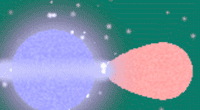
Lyra (琴座; 天琴座 tiānqín zuò); Lyr
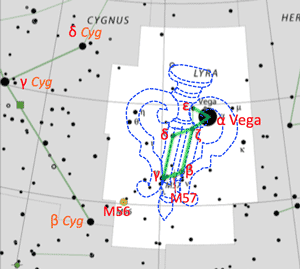
<Fig> Summer Triangle:
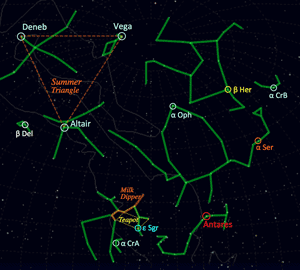
>Top <Mensa, Men>:
- Lα Caille labelled 11 stars α through λ (excluding κ). Stars as dim as (around mag 6.5) these were not generally given designations.
- α Men; G-type the brightest, mag 5.09 at 33 ly, making it the faintest constellation in the entire sky.
- β Men; G-type yellow giant star at 790 ly.
- γ Men; K-type orange star at 102 ly
- Large Magellanic Cloud (LMC) lies within the borders.
Mensa (テーブル山座; 山案座 shān'àn zuò); Men

>Top <Microscopium, Mic>
- γ Mic; G-type the brightest, yellow giant mag 4.768 at 229 ly, 2.5 M⦿, 10 R⦿, 64 L⦿.
- AX Mic; M-type, mag 6.67, the brightest red dwarf at 12.9 ly.
- Many objects are too faint to be seen with naked eye.
- One of 12 created constellation in 18C by French Nicholas Louis de Lacaille. The microscope's name had been Luteinized by Lacaille to Microscopium by 1763.
- The stars in Microscopium are previously considered the hind feet of Sagittarius.
Microscopium (显微镜座 xiǎnwēijìng zuò); Mic

>Top <Monoceros, Mon>
- α Mon; K-type, mag 3.94 at 148 ly.
- β Mon; B-type, the brightest tripple, mag 4.60 at 700 ly. William Hershel discovered it in 1781 and commented as one the the most beautiful sights in the heavens; 7 M⦿, 3200 L⦿.
- Open Cluster: NGC2244; Rosette nebula <Fig>
- A relatively modern constellation, first appeared in 1612 deined by Petrus Plancius..
- Its name is Greek for unicorn. It is a fictionary animal having a horse's head, a lion's tail, and a deer's legs.
- <Fig> Rosette nebula:

Monoceros (一角獣座; 麒麟座 qílín zuò); Mon

>Top <Musca, Mus>
- α Mus; B-type the brightest blue-white, mag 2.69, at 306 ly away lying south-southeast of Acrux
- β Mus; B-type binary, mag 3.0 at 311 ly, 6 M⦿, 3.5 R⦿, 2750 L⦿.
- δ Mus; K-type mag 3.61 at 91 ly.
- γ Mus; B-type mag 3.84 at 324 ly.
- ζ Mus; A-type white variable tripple, mag 4-4.3 at 330 ly, expanded 130 times.
- ε Mus; M-type red giant, variable 3.99-4.31 at 302 ly, 130 R⦿, 2000 L⦿。
- λ Mus; A-type mag 3.68 at 128 ly.
- μ Mus; K-type mag 4.75 at 432 ly.
- A small constellation in the deep southrn sky, created by Petrus Plancius n 1597.
- It was also known as Apis (<L. bee) for 200 years. Musca remain below the horizon for most Noerthern Hemisphere.
- French Nicolas Louis de Lacille called it la Mouche on 1756 version of his planisphere.
Musca (蝿座; 苍蝇座 cāngyíng zuò); Mus
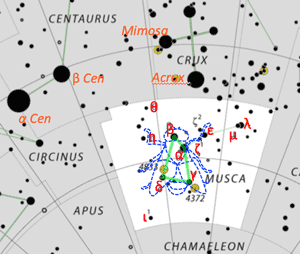
>Top <Norma, Nor>:
- γ2 Nor; G-type the brightest, mag 4.0, 10 R⦿, 45 L⦿.
- μ Nor; O-type, mag 4.91 at 3261 ly, one of the most luminous stars known; 40 M⦿, 25 R⦿, 339000 L⦿.
- Four star systems harbour planet.
- The Milky Way passes through Norma, containing 8 open clusters. <Fig>
- It is a small constellation in the southern sky, drawn up in 18C by Nicola Louis de Lacaille. Its name is Latin for normal, to represent a carpenter's square.
- Four brighter stars, γ, δ, ε, η make up a square.
- <Fig> Norma Cluster (Abell 3627) the most massive galaxy clusters near the center of the Great Attractor at 222M ly.
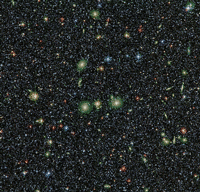
Norma (定規座; 矩尺座 jǔchǐ zuò); Nor
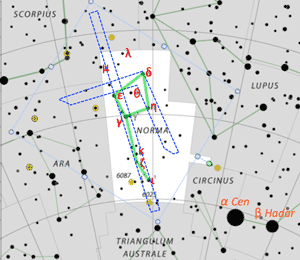
>Top <Octans, Oct>:
- β Oct; A-type, ma 4.13 at 140 ly.
- ν Oct; K-type the brightest giant star, mag 3.76, at 69 ly.
- δ Oct; K-type, mag 4.31 at 279 ly.
- Three brightest ν, β, δ Oct. are their highest point during in Oct-Nov.
- σ Oct; F-type, the southern pole star, mag 5.42 at 270 ly; just over 1º from the true pole. Its relative faintness is not practical for navigation.
- θ Oct; K-type, mag 4.78 at 221 ly.
- Octans is circumpolar to the South Celestial Pole, it can seen throughout the entire Southern Hemisphere.
- It is a faint constellation located in the deep southern sky. named after the octant, a navigational instrument; devised by French astonomer Nicolas Louis de Lacaille in 1752, during his expedition to the Cape of Good Hope.
- This is no mythology because of its extreme southerly latitude.
- Octans:
- <South Pole: Octans>
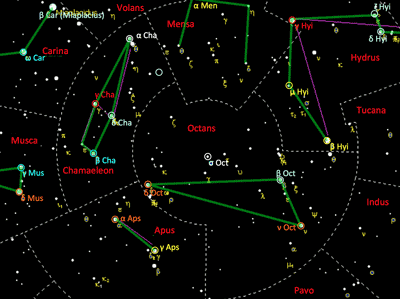
Octans (八分儀座; 南极座 nánjí zuò); Oct
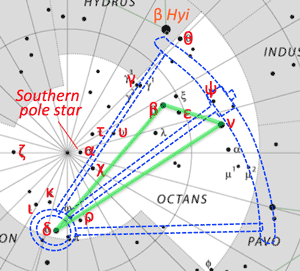
Octans:
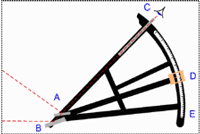
>Top <Ophiuchus, Oph>
- ☆α Oph (Rasalhague); 'head of the serpent charmer', A-type mag 2.08 at 47 ly.
- β Oph (Cebalrai); 'dog of the shepherd', K-type mag 2.76 at 82 ly.
- ☆η Oph (Sabik); (<the preceding one), A-type mag 2.43 at 49 ly.
- λ Oph (Marfik); (<the elbow)
- ζ Oph; O-type, mag 2.54 at 458 ly.
- δ Oph; M-type, mag 2.73 at 170 ly.
- κ Oph; K-type, mag 3.19 at 86 ly.
- ε Oph; G-type, mag 3.23 at 107 ly.
- θ Oph; B-type, mag 3.27 at 563 ly.
- ν Oph; K-type, mag 3.32 at 153 ly.
- Barnard Star, red dwarf, mag 9.51 at only 6 ly, 4th nearest star, and the closest in the Northern hemisphere. <Fig>
- Barnard Star was named after American astronomer E.E. Barnard in 1888.
- Ophiuches is depicted as a man grasping a serpent. The interposition of his body divides the Serpens into two parts (Serpens Caput and Serpens Cauda). Resalhague is circumpolar north of 78º north latitude. The constellation extends southwrd to -30º declination.
- <Fig> Closes Neighbours:
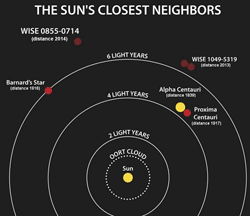
Ophiuchus (蛇遣座; 蛇夫座 shéfū zuò); Oph
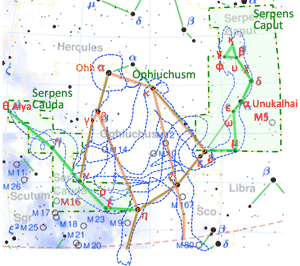
>Top <Orion, Ori>
- ★α Ori (Beterlgeuse); M-type 'right shoulder', red supergiant, semi regular variable, mag 0.50 Mv -5.85 at 643 ly, 12 M⦿, 887 M⦿, and 90000 L⦿., eventually exploding as supernovae in the next million years.
- ★β Ori (Rigel); B-type 6th brightest star in the sky, blue-white, mag 0.13 Mv -7.84 at 860 ly, 23 M⦿, 79 R⦿, 120000 L⦿.
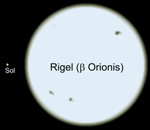
- ☆γ Ori (Bellatrix); B-type blue giant, mag 1.64 at 250 ly; 8.6 M⦿, 5.75 R⦿, 9211 L⦿.
- ☆δ Ori (Mintaka); meaning 'belt', in westernmost Orion's belt, B-type variabe, mag 2.23-2.35 at 900 ly.
- ☆ε Ori (Alnilam); B-type, in Orion's Belt, triple blue supergiant O/O/B-type, mag 1.69 at 2000 ly.
- ☆ζ Ori (Alnitak); O-type, the brightest eastern most in Orion's belt, triple, mag 1.70 at 820 ly.
- ☆κ Ori (Saiph); B-type, at Orion's right foot, mag 2.09 at 720 ly.
- Orion rises before Sirius, which was regarded as a god, Sah in Egypt.
- Navigational Orion:
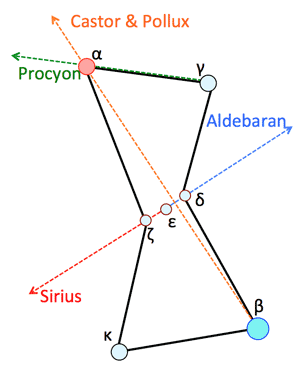
- It was named after Orion, a gigantic strong hunter in Greek mythology, born to Gorgon and Poseidon, god of the sea. Orion dared to say that he would kill every animal on the planet; the angry goddess tried to dispatch Orion with a scorpion.
- Orion's 7 brightest stars form a distinctive hourglass asterism.
- Bellatrix 250 (female warrior), Betelgeuse 640 (Red supergiant, 890 M⦿), Saiph 720, Rigel 860 each ly away.
- Origin of name of Rigel <Ar. rijl, 'foot'
- Alnitak 820, Mintaka 900, Alnilam 2,000 ly away.
- <Fig> Orion Belt:
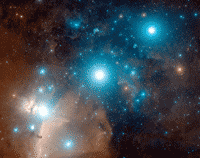
- <Fig> Orion Molecular Cloud Complex as most active stellar formation
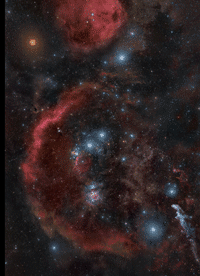
Orion (オリオン座; 猎户座 lièhù zuò); Ori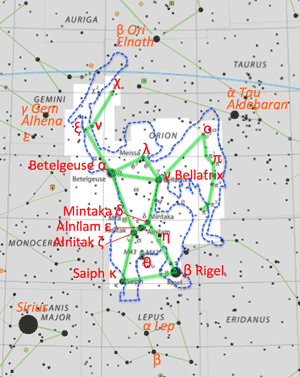 <Fig> Winter Triangle:
<Fig> Winter Triangle:
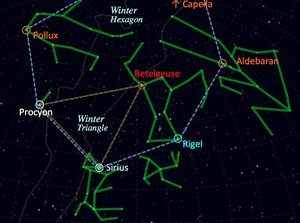
>Top <Pavo, Pav>:
- ☆α Pav; B-type brightest binary, mag 1.94 at 180 ly.
- β Pav; A-type, mag 3.42, at 135 ly.
- δ Pav; G-type Sun-lke more evolved star, yellow subgiant, mag 3.56 at 20 ly.
- λ Pav; B-type bright variable, mag 4.00-4.26 at 1400 ly; classified as shell star (circumstellar disc of gas surrounding the star's equater).
- In Greek myth the stars that are now the Peacock were Argos. Indeed, the peacock symbolized the starry firmament, Hera was believed to drive through the heavens in a chariot drawn by peacocks.
- Io, a beautiful princess of Argos, was lusted after by Zeus. Zeus changed Io into a heifer to deceive Hera and couple with her. Hera saw through Zeus's scheme and asked for the heifer as a gift. Hera promptly banished Io and arranged for Argus Panoptes to guard the now-pregnant Io from Zeus. Zeus entreated Hermes to save Io.
- Hera adorned the tail of a peacock with Argus's eyes in his honor.
Pavo (孔雀座 kǒngquè zuò); Pav
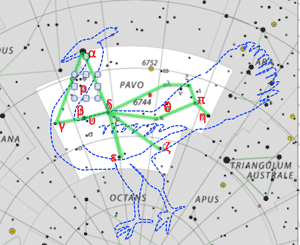
>Top <Pegasus, Peg>
- α,β,γ Peg and α And form the large asterism as the Square of Pegasus
- ☆α Peg (Markab); B-type, mag 2.48 at 140 ly.
- ☆β Peg (Scheat); M-type variable, mag 2.31-2.74 at 200 ly.
- γ Peg (Algenib);B-type mag 2.83 at 333 ly.
- ☆ε Peg (Enif); K-type the brightest orange supergiant variable, mag 0.7-3.0 at 670 ly located at muzzle of the horse.
- ζ Peg (Homam) mag 3.41 at 208 ly, B-type.
- In Greek mythology, Pegasus was a winged horse with magical powers. His hooves dug out a spring. Pegasus was the one who delivered Medusa's head to Polydectes.
- Pegasus is dominated by a square asterism, though one star δ Peg (Sirrah) is now α And usually called 'Alpheratz'.
- Pegasus-Perseus Constellations:
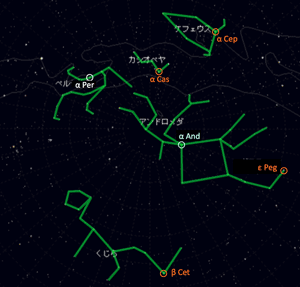
Pegasus (ペガスス座; 飞马座 fēimǎ zuò); Peg
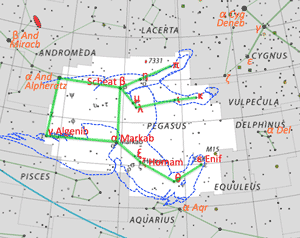
>Top <Perseus, Per>
- The galactic plane of Milky Way passes through Perseus.
- ☆α Per (Mirfak); F-type brightest yellow-whilte supergiant, at mag 1.80 at 510 ly, 8.5 M⦿, 68 R⦿.
- ☆β Per; (Algol <Ar. al-Ghul, Demon's head) B-type, best-known; varies mag. 2.1-3.39 over a period of 2.87 days at 93 ly.; eclipsing binary stars, 3.5 M⦿, and 180 luminous as ⦿, an secondary componet 3.5 R⦿, and 4.5 luminosity and 0.8 M⦿. These two are separated only o.05 AU.
- ζ Per; B-type, mag 2.84 at 982 ly.
- ε Per; B-type, mag 2.90 at 538 ly.
- It was named after Greek mythological hero Perseus, carrying the head of Medusa the Gorgon, who visage caused all who gazed upon her to turn to stone. Peerseus slew Medusa in her sleep, and Pegasus and Chrysaor appeared from her body.
- Perseus rescued Andromeda from the monster by killing it with his diamond sword. Perseus and Andromeda married and had six children.
- Perseids are called Meteor shower, from which they appear to come. The steam of debris is called the Perseid cloud stretches along the orbit of the comet Swift-Tuttle. The shower is visible in 9-14 Aug.
Perseus (ペルセウス座; 英仙座 yīngxiān zuò); Per
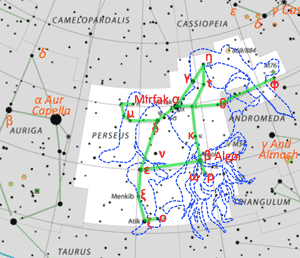
>Top <Phoenix Phe>
- ☆α Phe (Ankaa), (<Ar al-anqā, the phoenix). K-type the brightest, mag 2.38 at 77 ly.
- β Phe; G-type second brightest binary, both yellow giants˚˚ mag 3.31.
- γ Phe; M-type red gian, mag 3.39 at 235 ly.
- ψ Phe; M-type red giant, mag 4.3 at 340 ly, 85 R⦿.
- δ Phe; G-type, mag 3.93 at 142 ly.
- κ Phe; A-type, mag 3.94 at 78 ly.
- ζ Phe; B-type Algol type eclipsing binary, mag 3.9-4.4 in 1.7 days, at 300 ly.
- was published in 1597 by Petrus Plancius.
- Phoenix has actual precedent in ancient astornomy by Arabs.
- The introduction of a PHoenix into modern astornomy was by adoption rahter than by invention.
Phoenix (鳳凰座; 凤凰座 fènghuáng zuò); Phe
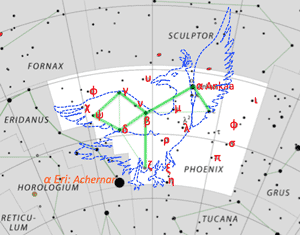
>Top <Pictor, Pic>
- α Pic; A-type the brightest, mag 3.27 at 97 ly.
- β Pic; A-type, mag 3.86 at 63 ly.
- γ Pic; K-type orange giant, mag 4.5 at 174 ly, has swollen to 1.4 R⦿.
- HD 40307; K-type orange, mag 7.17 at 42 ly; has 6 known planets discovered in 2008. One of them HD40307g is a potential super-Earth in the habitable zone with orbital 200 days, might be supporting liquid water on its surface.
- It is a constellation in the southern hemisphere, normally represented as an easel, Pictor was named by Nicolas-Louis de Lacaille in 18C.
- Habitable Exoplanets (Earth Eimilarity Index): by PHL 2017/2
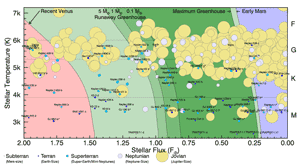
Pictor (画架座; 绘架座 huìjià zuò); Pic
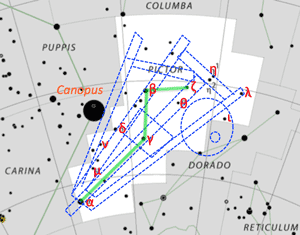
>Top <Pisces, Psc>
- One of zodiac constellation.
- α Psc Alrischa (the cord); A-type, mag 3.82 at 139 ly.
- β Psc Fum al Samakah (mouth of the fish); 492 ly, mag 4.48.
- δ Psc, Linteum (cord); K-type, mag 4.43 at 305 ly.
- γ Psc; G-type, mag 3.70 at 131 ly.
- ε Psc; K-type, mag 4.28 at 182 ly.
- η Psc; G-type the brightest, mag 3.62 at 294 ly.
- ω Psc; F-type, mag 4.03 at 106 ly.
- Pisces is associated with Aphrodite and Eros, who escaped from the monster Typhon by leaping onto the sea and transforming themselves into fish, tying together not to lose each other.
- The knot of the rope is marked by α Psc, called Al-Rischa (<Ar. the cord).
Pisces (魚座; 双鱼座 shuāngyú zuò); Psc
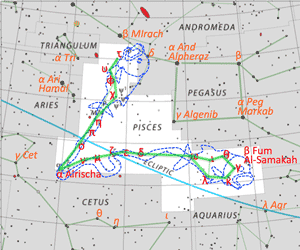
>Top <Piscis Austrinus, PsA>
- ★α PsA (Fomalhaut); A/K/M-type 18th brightest in the sky, triple star, A-type mag 1.16 at 25 ly, 1.92 M⦿, 1.84 R⦿, and 16.6 L⦿.
- β PsA; A-type, mag 4.29 at 148 ly.
- δ PsA; G-type, double star mag 4.2 at 170 ly.
- ζ PsA; K-type, mag 6.43 at 399 ly.
- In Greek mythology, it is knows as the Great Fish, swallowing the water being poured out by Aquarius.
- In Egyptian mythology, this fish saved the life of the Egyptian goddess Isis, so she place this fish into the heaven.
- Fomalhaut traditionally represents mouth of the fish.
Piscis Austrinus (南の魚座; 南鱼座 nányú zuò); PsA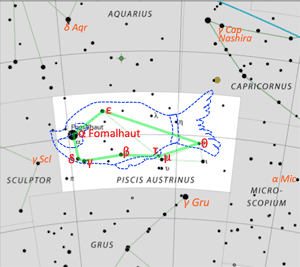
>Top <Puppis, Pup>
- ζ Pup (Naos) (<G. 'ship'); O-type brightest blue supergiant, mag 2.25 at 1100 ly; 22-56 M⦿, 14-26 R⦿, 550-800K L⦿, temperature 40-44K.
- ξ Pup (Asmidiske) (<G. 'gunwale'), mag 3.3.
- ρ Pup; F-type, mag 2.78 at 51 ly.
- HD69830; G-type, mag 5.95 at 41 ly; discovered having 3 Neptune size plants, first by Doppler spectroscopy; the outermost plante is located in the habitable zone and having water.
- It is a constellation in the southern sky. Puppis was originally part of an large constellation Argo Navis, divided into three parts (Carina, Vela, Puppis)
- Argo Navis was sub-divided in 1752 by Nicolas Louis de Lacaille.
- <Fig> One of the most luminous star in the Milky Way: (Bayer designation: α is not always the brightest star in the constellation. In 58 constellations α star is the brightest, but in 26 is not and 4 constellations have no α star.)
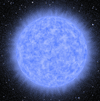
Puppis (艫とも座; 船尾座 chuánwěi zuò); Pup
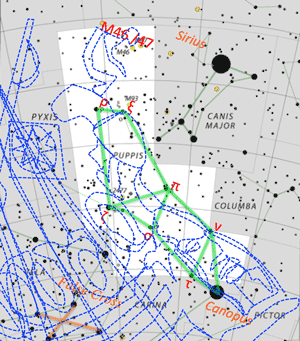
>Top <Pyxis, Pyx>
- α Pyx; B-type the brightest blue-white, mag 3.68 at 845 ly, and 9.4 M⦿, 22K L⦿.
- β Pyx; G-type, mag 3.97 at 388 ly.
- γ Pyx; K-type, mag 4.02 at 209 ly.
- κ Pyx; K-type, mag 4.62 at 487 ly.
- θ Pyx; M-type, mag 4.71 at 522 ly.
- λ Pyx; G-type, mag 4.71 at 182 ly.
- ζ Pyx; G-type, mag 4.86 at 236 ly.
- δ Pyx; A-type, mag 4.87 at 226 ly.
- Three stars have planetary systems, discovered by doppler sectroscopy.
- Planetary nebula; NGC2818 <Fig>
- It is a small and faint constellation in the southern sky, was introduced by Nicolas Louis de Lacaille in 18C.
- The plane of the Milky Way passes through Pyxis.
- Three bright stars, α, β, γ Pyx are in a rough line.
- <Fig> NGC 2818:
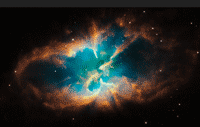
Pyxis (羅針盤座; 罗盘座 luópán zuò); Pyx
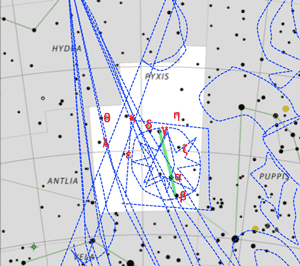
>Top <Q>:
>Top <Reticulum, Ret>:
- α Ret; the brightest G-type, mag 3.32 at 161 ly.
- β Ret; K-type, mag 3.84 at 97 ly.
- ε Ret; K-type binary, at 50 ly.
- ζ Ret; binary, similar to ⦿, at 39 ly.
- R Ret; a Mira variable.
Reticulum (レチクル座; 网罟座 wǎnggǔ zuò); Ret
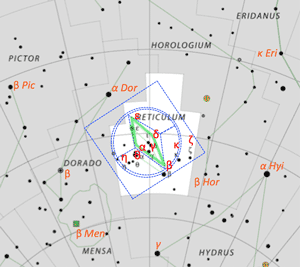
>Top <Sagitta, Sge>:
- α Sge (Sham); G-type yellow giant, mag 4.38, at 430 ly; 4 M⦿, has swollen 20 R⦿ and 340 L⦿.
- β Sge; G-type giant, mag 4.38 at 440 ly.
- γ Sge; M-type brightest red giant M-type, mag 3.47 at 258 ly.
- ε Sge; G-type multiple star, mag 5.66.
Sagitta (矢座; 天箭座 tiānjiàn zuò); Sge
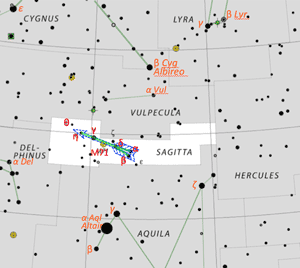
>Top <Sagittarius, Sgr>
- One of zodiac constellations.
- α Sgr (Rukbat); (<archer's knee) B-type, mag 3.96 182 ly.
- β1 Sgr (Arkab)(<achilles tendon); B-type, mag 3.96 at 378 ly.
- β2 Sgr (Arkab posterior); F-type, mag 4.27 at 139 ly; two star system, β1 & β2 are separated by 0.36º.
- ☆ε Sgr (Kaus Australis); B-type the brightest, mag 1.85 at 140 ly. (<sourthen part of the bow)
- ☆σ Sgr (Nunki); B-type 2nd brightest, mag 2.05 at 220 ly.
- ζ Sgr (Ascella) mag 2.61, double star.
- Asterism known as 'Teapot': by δ,ε,ζ,φ,γ,σ,τ Sgr.
- In Greek mythology, identified as a centaur (half human-horse)
- Sagittarius, the son of Philyra and Saturn and tutor to Jason, who wadi to have changed himself into a horse to escape his jealous wife Rhea.
- Crotus, son of Pan, who Greeks credited with the invention of archery. Crotus often went hunting on horseback and lived among the Muses, who requested that Zeus place him in the sky, where he is seen demonstrating archery. The arrow points towards Antares, the heart of the scorpion. Sagittarius stands poised to attack should Scourpius ever attack nearby Herclus or Orion.
Sagittarius (射手座; 人马座 rénmǎ zuò); Sgr
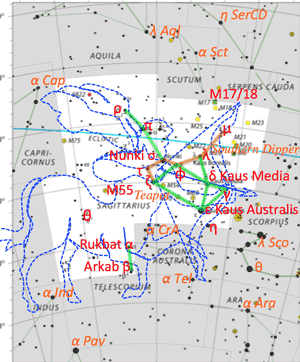
>Top <Scorpius, Sco>
- One of zodiac constellations.
- ★α Sco (Antares); rival of Mars, reddish hue M-type mag 0.96 at 600 ly, 12.4 M⦿, 883 R⦿, and 57500 L⦿. <Fig>
- ☆β Sco (Acrab or Graffias); B-type, a triple, mag 2.50 at 404 ly.
- ☆δ Sco (Dschubba) (<forehead); B-type varible mag 1.6-2.32 at 400 ly.
- ☆θ Sco (Sargas); F-type mag 1.84 at 270 ly.
- ☆λ Sco (Shaula); B-type mag 1.62 at 700 ly.
- λ/υ Sco (Lesath) (<string), consist of the scorpion's curved tail.
- ☆ε Sco; K-type mag 2.31 at 65 ly
- ☆κ Sco; B-type, mag 2.39 at 460 ly.
- ω Sco; ω1 & ω2 are an optical double.
- M6; Butterfly cluster
- M7; Ptolemy Cluster
- M80; a globular cluster of mag 7.3, 33K ly away.
- Orion boasted to goddess Artemis and her mother Leto that he would kill every animal on the Earth. Artemis and Leto sent a scorpion to deal with Orion. The pair battled and the scorpion killed Orion.
- Zeus raised the scorpion to heaven and afterwards did the same for Orion to serve as a reminder for mortals to curb their excessive pride.
- Every winter Orion hunts in the sky, but every summer he flees as the constellation of the scorpion comes.
- <Fig> Antares size: 883 R⦿:
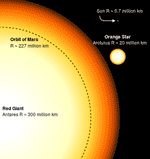
Scorpius (蠍座; 天蝎座 tiānxiē zuò); Sco
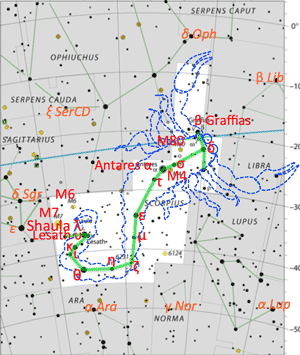
>Top <Sculptor, Scl>
- α Scl; B-type brightest variable, mag 4.30 at 672 ly.
- β Scl; B-type, mag 4.38 at 178 ly.
- γ Scl; K-type, mag 4.41 at 179 ly
- R Scl; a red giant the has been sourrounded by spirals of matter likely ejected 1800 years ago. <Fig>
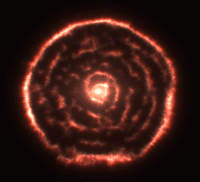
- Cartwheel Galaxy, 500M ly, mergered 300M years ago, with diameter 100K y. <Fig>
- French astronomer Nicolas-Louis de Lacaille described in 1751, depicting a three-legged table with a carved head on it and an artist mallet and two chisels. He named and symbolized the Age of Enlightenment.
- <Fig> Cartwheel Galaxy:
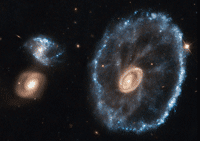
Sculptor (彫刻室座; 玉夫座 yùfū zuò); Scl
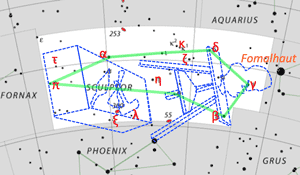
>Top <Scutum, Sct>
- α Sct; K-type the brightest mag 3.83 at 199 ly.
- β Sct; G-type the second brightest binary, mag 4.22 at 900 ly.
- γ Sct; A-type, mag 4.67 at 319 ly.
- δ Sct; F-type bluish white giant mag 4.72 at 202 ly, now coming at the direction of ⦿. Within 1.3M years it will come as close as 10 ly and will be much brighter than Sirius by that time.
- UY Sct; M-type red upergiant variable, mag 8.9-11.2 at 9500 ly. 7-10 M⦿, 1708 R⦿, 340,000 L⦿; the bright-red supergiant, the largest star currently known; its spectral lines of C/water/Si oxide, but no lines of O/Ne/other heavier elements. <Fig>
- <>It is a small constellation named in 1684 by Polish Johannes Hevelius. . Its name is Latin for 'shield'.
- <Fig> the largets star known:

Scutum (楯座; 盾牌座 dùnpái zuò); Sct
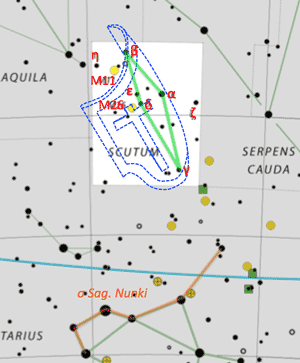
>Top <Serpens, Ser>
- <Serpens Caput>
- α Ser (Unkalhai); K-type, mag 2.63 at 74 ly.
- β Ser; A-type, mag 3.65 at 153 ly.
- η Ser; K-type, mag 3.23 at 62 ly.
- μ Ser; A-type, mag 3.54 at 156 ly.
- ξ Ser; F-type, mag 3.54 at 105 ly.
- ε Ser; A-type, mag 3.71 at 70 ly.
- τ1 Ser; M-type, variable, mag 5.13 at 900 ly.
- τ2 Ser; B-type, mag 6.22 at 430 ly.
- M5, globular cluster, one of the densest galxy clusters known <Fig>.
- M16 star cluster, 7000 ly, contains famous the Pillars of Creation, well-known star forming region <Fig>.
- It is unique in being split into two parts; Serpens Caput (Head) to the west and Serpens Cauda (Tail) to the east. Between these lies the constellation of Ophiuchus, 'Serpent-Bearer'.
- <Fig> the Pillars of Creation:
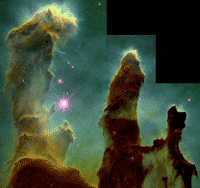
Serpens (蛇座; 巨蛇座 jùshé zuò); Ser
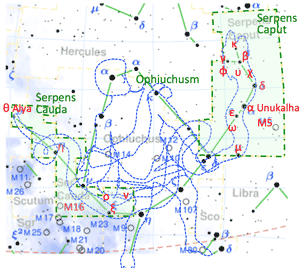
>Top <Sextans, Sex>
- α Sex; A-type, mag 4.49 at 280 ly.
- β Sex; B-type, variable star, mag 5.07 at 400 ly.
- γ Sex; A-type double star, mag 5.05 at 77 ly.
- Cosmos Redshift 7, brightest galaxy in the early universe.
- NGC 3115; called Spindle Galaxy is a field lenticular galaxy, 32M ly away, several times bigger than the Milky Way.
- In 1687 it was introduced by Johannes Hevelius; who frequently used the astronomical sextant in his observations.
- Sextans:
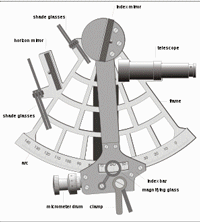
Sextans (六分儀座; lyiùfēnyí zuò); Sex
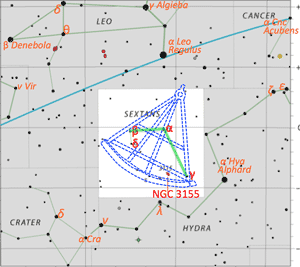
>Top <Taurus, Tau>:
- One of the zodian constellation.
- Taurus hosts nearest open clusters to Earth, Pleiades (M45) and Hyades.
- ★α Tau (Aldebaran); (<Ar al-dabarān, the follower), K-type red giant brightest, mag 0.86 at 65 ly, 1.5 M⦿, 44 R⦿, and 518 L⦿; which follows the Peiades.
- ☆β Tau (Elnath); B-type, mag 1.65 at 130 ly.
- ζ Tau; B-type mag 3.03 at 444 ly; 5.5 R⦿, 11 M⦿.
- λ Tau (Elthor); B-type, mag 3.41 at 483 ly.; 6.6 R⦿, 4000 L⦿.
- ο Tau; B-type, mag 4.87 at 290 ly.
- τ Tau; B-type, mag 4.26 at 400 ly.
- Pleiades (M45) is also named Seven Sisters; actually has 500-1000 stars around 100m years old. <Fig>
- Hyades cluster: γ, δ, ε, θ Tau identifes as the head of Taurus. The age of Hyades is about 625m years, 400 M⦿. Messier did not include the Hyades in his catalog.
- In NW part of Taursu is theType II supernova remant Crab Nebula ( M1), mag. 8.4., recorded to appear in 1054. Crab pulsar, a neutron star was discovered in 1968 as a remnat of the supernova., rotating 30 times/s.
- In Nov., Taurid meteor shower appears.
- In Greek mythology, Taurus was identified with Zeus to abduct Europa a legendary Phoenician princess.
- Hyades were five daughters of Atlas and half-sisters to the Pleiades.
- In Illiad the stars of Hyades appear along with the Pleiades, Ursa Major and Orion on the shield that the god Hephaistos made for Achilles.
- <Fig> Pleiades (M45); opne cluster composed of 3000 stars at 400 ly.

Taurus (牡牛座; 金牛座 jīnniú zuò); Tau
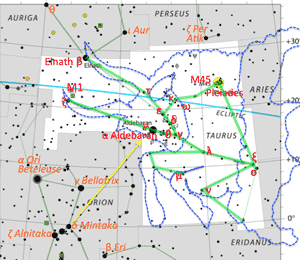
>Top <Telescopium, Tel>
- α Tel; B-type the brightest blue-white subgiant, mag 3.5 at 250 ly; 5.2 of M⦿, and 3.3 of R⦿, radiating 800 L⦿。
- δ1 Tel; B-type, mag 4.9 at 710 ly.
- ζ Tel; K-type second brightest orange, mag 4.1; 1.53 tiems M⦿, shines 512 time L⦿, at 127 ly.
- It is a minor constellation in the southern sky, named in 1751 by Nicolas-Lous de Lacaille after had had observed and catalogued 10,000 southern stars during two year stay in Cape of Good Hope. Its name is Latinized form of Greek for telescope
Telescopium (望遠鏡座; 望远镜座 wàngyuǎnjìng zuò); Tel
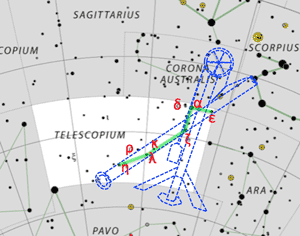
>Top <Triangulum, Tri>
- α Tri; F-type second brightest yellow-white subgiant, mag 3.41 at 63 ly; the apex of the triange.
- β Tri; A-type brightest white giant, actually binary, mag 3.00 at 127 ly.
- γ Tri; A-type white, mag 4.00 at 112 ly; double R⦿, and 33 L⦿.
- It is a small constellation in the northern sky. Its Latin name for 'triangle', derived from its three briger stars.
- The ancient Greeks call Triangulum Deltoton (Δελτωτον). Eratosthenes likned it with the Nile Delta.
Triangulum (三角座; sānjiǎo zuò); Tri
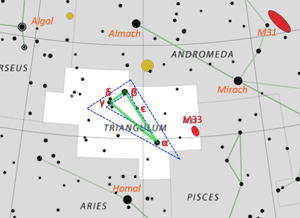
>Top <Triangulum Australe, TrA>
- ☆α TrA (Atria); K-type mag 1.91 at 424 ly; 5500 L⦿.
- β TrA; F-type double, mag 2.85 at 40 ly.
- γ TrA; A-type; mag 2.87 at 180 ly.
- δ TrA; G-type yellow giant at 606 ly.
- It is a small constellation in the far southern hemispher. Its name is Latin ofr 'the southern triangel', depicted by Petrus Placius in 1589, and charted by Nicolas Louis de Lacaille.
Triangulum Australe (南の三角; nánsānjiǎo zuò); TrA
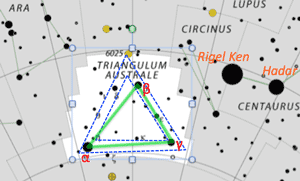
>Top <Tucana, Tuc>
- α Tuc; K-type the brightest binary, mag 2.86 at 200 ly; 37 R⦿, 424 L⦿.
- β Tuc; F-type yellow-white, mag 4.00 at 75 ly.
- δ Tuc; B-type, mag 4.4 at 251 ly.
- It is a constellation in the southernn sky named after toucan, a South American bird; conveived by 16C by Petrus Plancius.
- Nicolas Louis de Lacaille labels them in 1756.
Tucana (巨嘴鳥きょしちょう座; 杜鹃座 dùjuān zuò); Tuc
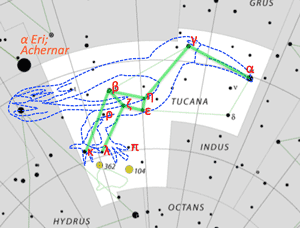
>Top <Ursa Major, UMa>:
- The most recognizable asterism, 'Big Dipper' or 'the Plough', used as a navigational pointer towards Polaris in UMi.
- ☆α UMa (Dubhe, <Ar. the bear); G-type mag 1.79 at 120 ly.
- ☆β UMa (Merak, <loins of the bear); A-type, mag 2.37 at 79 ly.
- ☆γ UMa (Phecda); A-type, mag 2.44 at 84 ly.
- δ Uma (Megrez); A-type, mag 3.3 at 58 ly.
- ☆ε UMa (Alioth, <black horse); A-type brightest star, mag 1.77 at 81 ly.
- ζ1 UMa (Mizar, <girdle); A-type forms famous double; the ability of this resolution is quoted as an eyesight test, mag 2.27 at 78 ly.
- ☆η UMa (Alkaid <end of tail); B-type mag 1.86 at 100 ly.
- stars of the Big Dipper (except α and η) have proper motions toward Sagittarius.
- In Roman mythology, Jupiter lusts after a young woman named Callisto, a nymph of Diana. Juno, Jupiter's jealous wife, discovers that Callisto has a son named Arcas; Juno then transformed Callisto into a bear. Callisto later encounters her son Arcas, who almost shoots the bear, but to avert the tragedy, Jupiter turns Arcas into a bear too and puts them both in the sky, forming UMa and UMi.
Ursa Major (大熊座; dàxióng zuò); UMa
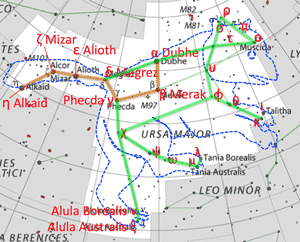
>Top <Ursa Minor, UMi>
- Little Dipper (<L. lesser-Bear): 7 stars with four in its bowl like the Big Dipper.
- ☆α UMi (Polaris); F-type brightest, yellow-white supergiant and Cepheid variable star, mag 1.97-2.0 at 430 ly, 5.4 M⦿, 37.5 R⦿, 1260 L⦿.
- ☆β UMi (Kochab); K-type aging orange giant, mag 2.08 at 130 ly, which had been near the north pole in 1500-500BC.
- γ UMi (Pherkad); A-type mag 3.04 at 480 ly.
- δ UMi; A-type mag 4.35 at 183 ly.
- ε UMi; G-type mag 4.21 at 346 ly.
- ζ UMi; A-type mag 4.29 at 376 ly.
- η UMi; F-type mag 4.95 at 97 ly.
- UMi and UMa were related by the Greeks to the myth of Callisto and her son Arcas, both place in the sky by Zeus.
- Latin word for north 'septentrio' <septem(seven)+triones (oxen), from seven oxen driving a plough. This name has also been attached to UMa.
- UMi has been important for navigation because of Polaris. In Inuit, Polaris, Kochab and Pherkad were known as never moving.
- <Fig> North Pole Stars:
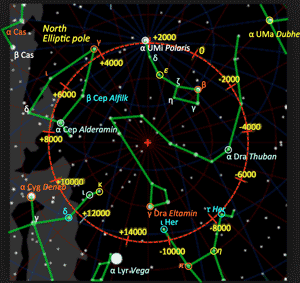
Ursa Minor (小熊座, xiǎoxióng zuò); UMi
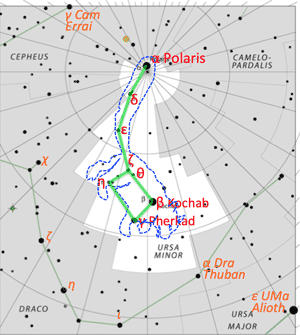
>Top <Vela, Vel>:
- ☆γ1 Vel; WC/O-type, mag 1.72 at 840 ly. <Fig> Wolf-Rayet star, usual spectra showing H/N/C.
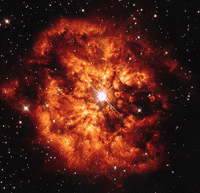
- ☆δ Vel; A-type, mag 1.96 at 80 ly.
- ☆κ Vel; B-type, mag 2.46 at 540 ly.
- ☆λ Vel; K-type variable mag 2.14-2.30 at 570 ly.
Vela (帆座; 船帆座 chuánfān zuò); Vel
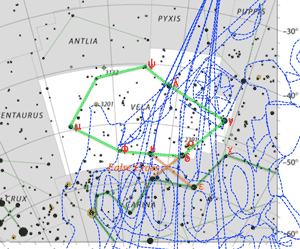
>Top <Virgo, Vir>
- One of the zodiac constellations.
- ★α Vir (Spica); B-type brightest, mag 0.97 at 250 ly, 10 M⦿, 7.4 R⦿, 12000 L⦿.
- β Vir (Zavijava); F-type mag 3.60 at 36 ly.
- γ Vir (Porrima); F-type mag 2.74 at 38 ly.
- δ Vir (Auva); M-type mag 3.40 at 198 ly.
- ε Vir (Vindemiatrix); G-type mag 2.83 at 102 ly.
- χ Vir; K-type oragne giant, mag 4.64 at 293 ly; has one of the most massive planet (11 Mj).
- Greeks and Romans associated Virgo with their goddess of wheat or agriculture who is the mother of Persephone
- Alternatively, she was identified as virgin goddess justitia or Astraea, holding the scales of justice as the constellation Libra.
- In the Middle Ages, Virgo was associated with the Blessed Virgin Mary.
- Virgo is often portrayed carrying two sheaves of wheat; one is marked by Spica.
- <Fig> Spring Triangle:
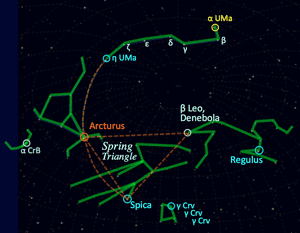
Virgo (乙女座; 室女座 shìnǚ zuò); Vir
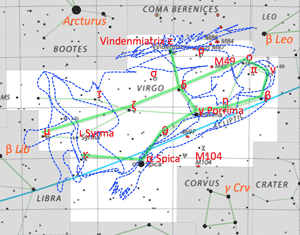
>Top <Volans, Vol>
- γ Vol; F/K-type double star, mag 3.62 at 160 ly.
- ε Vol; B-type double star, mag 4.33 at 560 ly.
- HD 76700; G-type Sun-like star mat 8.13 at 195 ly.
- It represents a flying fish, shortened its original, Piscis Volans, publishe in 1597 by Petrus Planciius.
- The flying fish was depicted as accompnaying the ship Argo Navis, and being chased by the predatory fish by adjoing Dorado.
Volans (飛魚座; 飞鱼座 fēiyú zuò); Vol
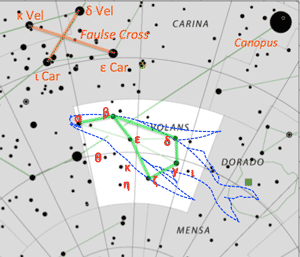
>Top<Vulpecula, Vul>
- No stars brighter than 4th mag.
- α Vul; M-type the brightest red giant, mag 4.40 at 297 ly.
- M27 (Dumbbell Nebula) or NGC6853; mag 7.5 at 1360 ly, bright planetary nebula discovered in 1764 as the very first object of its kind. <Fig>
- A faint constellation in the northern sky; its name is Latin for little fox, identified in 17C and is located in the middle of the Summer Triangle (asterism of Deneb, Vega, and Altair)
- <Fig> Dumbbell Nebula:
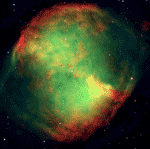
Vulpecula (小狐座; 狐狸座 húlí zuò); Vul
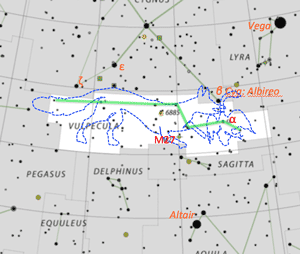
>Top <W>:
>Top <X>:
>Top <Y>:
>Top <Z>:
Data
Mithology & History
Map
Pinyin
Index
; Andromeda ; Antilia ; Apus ; Aquarius ; Aquila ; Ara ; Aries ; Auriga ; Boötes ; Caelum ; Camelopardalis ; Cancer ; CanesVenatici ; CanisMajor ; CanisMinor ; Capricornus ; Carina ; Cassiopeia ; Cenntaurus ; Cepheus ; Cetus ; Chamaeleon ; Circinus ; Columba ; ComaBerenices ; CoronaAustralis ; CoronaBorealis ; Corvus ; Crater ; Crux ; Cygnus ; Delphinus ; Dorado ; Draco ; Equuleus ; Eridanus ; Fornax ; Gemini ; Grus ; Hercules ; Horologium ; Hydra ; Hydrus ; Indus ; Lacerta ; Leo ; LeoMinor ; Lepus ; Libra ; Lupus ; Lynx ; Lyra ; Mensa ; Microscopium ; Monoceros ; Musica ; Norma ; Octans ; Ophiuchus ; Orion ; Pavo ; Pegasus ; Perseus ; Phoenix ; Pictor ; Pisces ; PiscisAustrinus ; Puppis ; Pyxis ; Reticulum ; Sagitta ; Sagittarius ; Scorpius ; Sculptor ; Scutum ; Serpens ; Sextans ; Taurus ; Telescopium ; Triangulum ; TrianulumAustrale ; Tucana ; UrsaMajr ; UrsaMinor ; Vela ; Virgo ; Volans ; Vulpecula ;
Constellations Summary
|
Cat: SCI |
|
IAU, Wikipedia, et al. |
17322u/18227r |
Pinyin |
||||||||||||||||||||||||||||
|---|---|---|---|---|---|---|---|---|---|---|---|---|---|---|---|---|---|---|---|---|---|---|---|---|---|---|---|---|
Index |
; And ; Ant ; Aps ; Aqr ; Aql ; Ara ; Ari ; Aur ; Boo ; Cae ; Cam ; Cnc ; CVn ; CMa ; CMi ; Cap ; Car ; Cas ; Cen ; Cep ; Cet ; Cha ; Cir ; Col ; Com ; CrA ; CrB ; Crv ; Crt ; Cru ; Cyg ; Del ; Dor ; Dra ; Equ ; Eri ; For ; Gem ; Gru ; Her ; Hor ; Hya ; Hyi ; Ind ; Lac ; Leo ; LMi ; Lep ; Lib ; Lup ; Lyn ; Lyr ; Men ; Mic ; Mon ; Mus ; Nor ; Oct ; Oph ; Ori ; Pav ; Peg ; Per ; Phe ; Pic ; Psc ; PsA ; Pup ; Pyx ; Ret ; Sge ; Sgr ; Sco ; Scl ; Sct ; Ser ; Sex ; Tau ; Tel ; Tri ; TrA ; Tuc ; UMa ; UMi ; Vel ; Vir ; Vol ; Vul ; | |||||||||||||||||||||||||||
|
|
|||||||||||||||||||||||||||
| # | V | Mv | Ra | Dec | Proper name of 1st magnitude ★ | Kº | Spe: OBAFGKM | ly | M⦿ | R⦿ | L⦿ | Type |
| 0 | -26.74 | 4.82 | Sun ⦿; 太阳 tàiyáng | 6 | G2V | 0.0000158 |
|
|||||
| 1 | -1.46 | 1.42 | 06.45 | -16.42 | Sirius (α CMa) 天狼星 tiānláng xīng | 25 | A1, DA2 | 8.6 | 0.98 |
0.0084 | 0.056 | Bin |
| 2 | -0.74 | -5.71 | 06.23 | -52.41 | Canopus (α Car) 老人 lǎorén xīng | 7 | A9II | 310 | 8.0 | 71 | 10.7K | |
| 3 | -0.27 | 4.38 | 14.39 | -60.50 | Rigil Kentaurus (α Cen) 南門二 nánmén èr | 5.8 | G2V, K1V | 4.37 | 1.1 | 1.23 | 0.5 | Bin |
| 4 | -0.05 | -0.30 | 14.15 | +19.10 | Arcturus (α Boo) 大角 dàjiǎo | 4.3 | K0Ⅲ | 37 | 1.08 | 25.4 | 170 | |
| 5 | 0.03 | 0.58 | 18.36 | +38.47 | Vega (α Lyr) 织女一 zhīnǚ yī | 9.6 | A0Va | 25 | 2.14 | 2.36 | 40.1 | Var |
| 6 | 0.08 | 0.17 | 05.16 | +45.59 | Capella (α Aur) 五车二 wǔchē èr | 5.7 | K0Ⅲ, G1Ⅲ | 42 | 2.57 | 11.98 | 78.7 | Bin |
| 7 | 0.13 | -7.84 | 05.14 | -08.12 | Rigel (β Ori) 参宿七 cānsù qī | 11 | B8Ia, B9V | 860 | 23 | 78.9 | 120K | Bin |
| 8 | 0.34 | 2.66 | 07.39 | +05.13 | Procyon (α CMi) 南河三 nánhé sān | 6.5 | F5 IV-V | 11 | 1.50 | 2.05 | 6.93 | Bin |
| 9 | 0.46 | -1.46 | 01.37 | -57.14 | Achernar (α Eri) 水委一 shuǐwěi yī | 15 | B6Vep | 139 | 6.7 | 7.3 | 3150 | |
| 10 | 0.50 | -5.85 | 05.55 | +07.24 | Betelgeuse (α Ori) 参宿四 cānsù sì | 3.6 | M1Ia, M2Iab | 640 | 11.6 | 887 | 90K | Bin |
| 11 | 0.61 | -4.53 | -4.53 | -60.22 | Hadar (β Cen) 马腹一 mǎfù yī | 25 | B1III, ", B1V | 390 | 10.7 | 41.7 | Tri | |
| 12 | 0.76 | 2.22 | 19.50 | +08.52 | Altair (α Aql) 河鼓二 hégǔ èr | 6.9 | A7 V | 17 | 1.79 | 1.63 | 10.6 | |
| 13 | 0.76 | 3.77 | 12.26 | -63.05 | Acrux (α Cru) 十字架二 shízìjià èr | 28 | B0.5 IV, B1 V | 320 | 17.8 | 25K | ||
| 14 | 0.86 | -0.64 | 04.35 | +16.30 | Aldebaran (α Tau) 毕宿五 bìsù wǔ | 3.9 | K5Ⅲ | 65 | 1.5 | 44.2 | 518 | |
| 15 | 0.96 | -5.28 | 16.29 | -26.25 | Antares (α Sco) 心宿二 xīnsù èr | 3.5 | M1.5 lab, B3V | 600 | 12.4 | 883 | 57.5K | Bin |
| 16 | 0.97 | -3.55 | 13.25 | -11.09 | Spica (α Vir)角宿一 jiǎosù yī | 22.4 | B1Ⅲ-Ⅳ, B2V | 250 | 10.25 | 7.4 | 12.1K | Bin |
| 17 | 1.14 | 1.08 | 07.45 | +28.01 | Pollux (β Gem) 北河三 běihé sān | 3.9 | K0Ⅲ | 34 | 2.04 | 8.8 | 43 | |
| 18 | 1.16 | 1.72 | 22.57 | -29.37 | Fomalhaut (α PsA) 北落师门 běiluòshī mén | 8.6 | A3V, K5Vp, M4V | 25 | 1.92 | 1.84 | 16.6 | Trip |
| 19 | 1.25 | -8.38 | 20.41 | +45.16 | Deneb (α Cyg) 天津四 tiān jīn sì | 8.5 | A2Ia | 2600 | 19 | 203 | 196K | |
| 20 | 1.25 | -3.36 | 12.47 | -59.41 | Mimosa (β Cru) 十字架三 shízìjià sān | 27 | B0.5Ⅲ, B2V | 280 | 16 | 8.4 | 34K | Bin |
| 21 | 1.40 | -0.52 | 10.08 | +11.58 | Regulus (α Leo) 轩辕十四 xuānyuán shísì | 13 | B8V, K2V, M4V | 79 | 3.8 | 3.1 | 288 | Bin×2 |
| 51 | 1.98 | -3.6 | 02.31 | +89.15 | Polaris (α UMi) 勾陈一 gōuchén yī | 6 | F7Ib | 323 | 5.4 | 37.5 | 1260 | Tri |
| # | V | Mv | Ra | Dec | Proper name | Kº | Spectrum | ly | M⦿ | R⦿ | L⦿ | Type |
| North (Ra: 21h - 03h) | East (Ra: 03h - 09h) | South (Ra: 09h - 15h) | West (Ra: 15h -21h) | |
| Dec (+) | 2115+5 αEqu; 2118+62 αCep; 22.31+30 αLac; 0008+29 αAnd; 0040+56 αCas; 0131+15 ηPsc; 0207+23 αAri; 0209+34 βTri; 0231+89 Polaris; |
0324+49 αPer; |
0921+34 αLyn; 1008+11 Regulus; |
1534+26 αCrB; 1630+21 βHer; 1734+12 αOph; 1756+51 γDra; 1836+38 Vega; 1928+24 αVul; 1950+08 Altair; 1958+19 γSge; 2037+14 βDel; 2041+45 Deneb; |
| Dec (-) | 213-05 βAqr; 2101-32 γ Mic; 2147-16 δCap; 2208-46 αGru; 2218-60 αTuc; |
0312-28 αFor; 0414-42 αHor; |
0927-08 αHya; 1007-0.2 αSex; 1027-31 αAnt; 1124-17 δCrt; 1215-17 γCrv; 12.26-63 Acrux; 1247-59 Mimosa; 1325-11 Spica; 1403-60 Hadar; 1439-60 Rigel-Ken; 1442-64 αCir; 1447-79 αAps; | 1517-09 βLib; 1619-50 γ2Nor; 1629-26 Antares; 1648-69 αTrA; 1725-55 βAra; 1826-45 αTel; 1909-37 αCrA; 2025-56 αPav; 2037-47 αInd; |
>Top <Location>: |
|
>Top Apparent magnitude (V), Absolute magnitude (Mv) &
|
>Top Distance (ly) & Absolute magnitude (Mv):
|
Data |
Mithology & History |
Map |
>Top <Andromeda ; And>
|
|
Andromeda(アンドロメダ座, 仙女座xiānnǚ); And |
>Top <Antlia, Ant>
|
|
Antlia (ポンプ座; 唧筒座 jītǒng zuò); Ant |
>Top <Apus, Aps>
|
|
Apus (風鳥座; 天燕座 tiānyàn zuò); Aps |
>Top <Aquarius, Aqr>
|
|
Aquarius (水瓶座; 宝瓶座 bǎopíng zuò); Aqr |
<News 2017/2 by NASA> TRAPPIST-1
|
Trappist-1: compared by Jupiter. Travel poster to Trappist-1: |
 |
>Top <Aquila, Aql>
|
|
Aquila (鷲座; 天鹰座; tiānyīng zuò) |
>Top <Ara, Ara>
|
|
Ara (祭壇座; 天坛座 tiāntán zuò); Ara |
>Top <Aries, Ari>
|
|
Aries (牡羊座;
白羊座 báiyáng zuò); Ari |
>Top <Auriga, Aur>
|
|
Auriga (馭者座; 御夫座 yùfū zuò); Aur |
>Top <Boötes, Boo>:
|
|
Boötes (牛飼い座; 牧夫座 mùfū zuò); Boo |
>Top <Caelum, Cae>:
|
|
Caelum (彫刻具座; 雕具座 diāojù zuò); Cae |
>Top <Camelopardalis, Cam>
|
|
Camelopardalis (麒麟座; 鹿豹座 lùbào zuò); Cam |
>Top <Cancer, Cnc>
|
|
Cancer (蟹座;巨蟹座 jùxiè zuò); Cnc |
>Top <Canes Venatici, CVn>
|
|
Canes Venatici (猟犬座; 猎犬座 lièquǎn zuò); CVn |
>Top <Canis Major, CMa>
|
|
Canis Major (大犬座; dàquǎn zuò); CMa |
>Top <Canis Minor, CMi>
|
|
Canis Minor (小犬座; xiǎoquǎn zuò); CMi |
>Top <Capricornus, Cap>
|
|
Capricornus (山羊座; 摩羯座 mójié zuò); Cap |
>Top <Carina, Car>
|
|
Carina (竜骨座; 船底座 chuándǐ zuò); Car |
>Top <Cassiopeia, Cas>
|
|
Cassiopeia (カシオペア座; 仙后座 xiānhòu zuò); Cas |
>Top <Centaurus, Cen>
|
|
Centaurus (ケンタルス座; 半人马座 bànrénmǎ zuò); Cen
|
>Top <Cepheus, Cep>
|
|
Cepheus (ケフェウス座; 仙王座 xiānwáng zuò); Cep |
>Top <Cetus, Cet>
|
|
Cetus (鯨座; 鲸鱼座 jīngyú zuò); Cet |
>Top <Chamaeleon, Cha>
|
|
Chamaeleon (カメレオン座; 蝘蜓座 yǎntíng zuò); Cha |
>Top <Circinus, Cir>
|
It is a small, faint constellation in the southern sky, first defined in 1756 by French astronomer Nicolas-Louis de Lacaille. Its name is Latin for compass, a drafting tool for drawing circles. | Circinus (コンパス座; 圆规座 yuánguī zuò); Cir |
>Top <Columba, Col>
|
|
Columba (鳩座; 天鸽座 tiāngē zuò); Col |
>Top <Coma Berenices, Com>
|
|
Coma Berenices (髪座; 后发座 hòufà zuò); Com |
>Top <Corona Austrina, CrA>
|
|
Corona Austrina (南の冠座; 南冕座 nánmiǎn zuò); CrA |
>Top <Corona Borealis, CrB>
|
|
Corona Borealis (冠座; 北冕座 běimiǎn zuò); CrB |
>Top <Corvus, Crv>
|
|
Corvus (烏座; 乌鸦座 wūyā zuò); Crv |
>Top <Crater, Crt>
|
|
Crater (コップ座; 巨爵座 jùjué zuò); Crt |
>Top <Crux, Cru>
|
|
Crux (南十字座; nánshízì zuò); Cru |
>Top <Cygnus, Cyg>
|
|
Cygnus (白鳥座; 天鹅座 tiān'é zuò) |
>Top <Delphinus, Del>:
|
|
Delphinus (海豚座; hǎitún zuò); Del |
>Top <Dorado, Dor>
|
|
Dorado (旗魚座; 剑鱼座 jiànyú zuò); Dor |
>Top <Draco, Dra>
|
|
Draco (竜座; 天龙座 tiānlóng zuò); Dra |
>Top <Equuleus, Equ>:
|
|
Equuleus (小馬座; 小马座 xiǎomǎ zuò); Equ |
>Top <Eridanus, Eri>
|
|
Eridanus (エリダヌス座; 波江座 bōjiāng zuò); Eri |
>Top <Fornax, For>:
|
Fornax (炉座; 天炉座 tiānlú zuò); For |
>Top <Gemini, Gem>:
|
|
Gemini (双子座; shuāngzi zuò); Gem |
>Top <Grus, Gru>
|
|
Grus (鶴座; 天鶴座 tiānhè zuò); Gru |
>Top <Hercules, Her>:
|
|
Hercules (ヘルクレス座; 武仙座 wǔ xiān zuò); Her |
>Top <Horologium, Hor>
|
|
Horologium (時計座; 时钟座 shízhōng zuò); Hor |
>Top <Hydra, Hya>
|
|
Hydra (海蛇座; 长蛇座 chángshézuò zuò); Hya |
>Top <Hydrus, Hyi>
|
|
Hydrus (水蛇座; shuǐshé zuò) |
>Top <Indus, Ind>:
|
Indus (インディアン座; 印第安座 yìndìān zuò); Ind |
>Top <J>: |
>Top <K>: |
>Top <Lacerta, Lac>:
|
Lacerta (蜥蜴座; 蝎虎座 xiēhǔ zuò); Lac |
>Top <Leo, Leo>
|
|
Leo (獅子座; shīzi zuò); Leo |
>Top <Leo Minor, LMi>
|
|
Leo Minor (小獅子座; 小狮座 xiǎoshī zuò); LMi |
>Top <Lepus, Lep>
|
|
Lepus (兎座; 天兔座 tiāntù zuò); Lep |
>Top <Libra, Lib>
|
|
Libra (天秤座; tiānchèng zuò); Lib |
>Top <Lupus, Lup>
|
|
Lupus (狼座; 豺狼座 cháiláng zuò); Lup |
>Top <Lynx, Lyn>
|
|
Lynx (山猫座; 天猫座 tiānmāo zuò); Lyn |
>Top <Lyra, Lyr>
|
|
Lyra (琴座; 天琴座 tiānqín zuò); Lyr
|
>Top <Mensa, Men>:
|
Mensa (テーブル山座; 山案座 shān'àn zuò); Men |
>Top <Microscopium, Mic>
|
|
Microscopium (显微镜座 xiǎnwēijìng zuò); Mic |
>Top <Monoceros, Mon>
|
|
Monoceros (一角獣座; 麒麟座 qílín zuò); Mon |
>Top <Musca, Mus>
|
|
Musca (蝿座; 苍蝇座 cāngyíng zuò); Mus |
>Top <Norma, Nor>:
|
|
Norma (定規座; 矩尺座 jǔchǐ zuò); Nor |
>Top <Octans, Oct>:
|
|
Octans (八分儀座; 南极座 nánjí zuò); Oct
|
>Top <Ophiuchus, Oph>
|
|
Ophiuchus (蛇遣座; 蛇夫座 shéfū zuò); Oph |
>Top <Orion, Ori>
|
|
Orion (オリオン座; 猎户座 lièhù zuò); Ori |
>Top <Pavo, Pav>:
|
|
Pavo (孔雀座 kǒngquè zuò); Pav |
>Top <Pegasus, Peg>
|
|
Pegasus (ペガスス座; 飞马座 fēimǎ zuò); Peg |
>Top <Perseus, Per>
|
|
Perseus (ペルセウス座; 英仙座 yīngxiān zuò); Per |
>Top <Phoenix Phe>
|
|
Phoenix (鳳凰座; 凤凰座 fènghuáng zuò); Phe |
>Top <Pictor, Pic>
|
|
Pictor (画架座; 绘架座 huìjià zuò); Pic |
>Top <Pisces, Psc>
|
|
Pisces (魚座; 双鱼座 shuāngyú zuò); Psc |
>Top <Piscis Austrinus, PsA>
|
|
Piscis Austrinus (南の魚座; 南鱼座 nányú zuò); PsA |
>Top <Puppis, Pup>
|
|
Puppis (艫とも座; 船尾座 chuánwěi zuò); Pup |
>Top <Pyxis, Pyx>
|
|
Pyxis (羅針盤座; 罗盘座 luópán zuò); Pyx |
>Top <Q>: |
>Top <Reticulum, Ret>:
|
Reticulum (レチクル座; 网罟座 wǎnggǔ zuò); Ret |
>Top <Sagitta, Sge>:
|
Sagitta (矢座; 天箭座 tiānjiàn zuò); Sge |
>Top <Sagittarius, Sgr>
|
|
Sagittarius (射手座; 人马座 rénmǎ zuò); Sgr |
>Top <Scorpius, Sco>
|
|
Scorpius (蠍座; 天蝎座 tiānxiē zuò); Sco |
>Top <Sculptor, Scl>
|
|
Sculptor (彫刻室座; 玉夫座 yùfū zuò); Scl |
>Top <Scutum, Sct>
|
|
Scutum (楯座; 盾牌座 dùnpái zuò); Sct |
>Top <Serpens, Ser>
|
|
Serpens (蛇座; 巨蛇座 jùshé zuò); Ser |
>Top <Sextans, Sex>
|
|
Sextans (六分儀座; lyiùfēnyí zuò); Sex |
>Top <Taurus, Tau>:
|
|
Taurus (牡牛座; 金牛座 jīnniú zuò); Tau |
>Top <Telescopium, Tel>
|
|
Telescopium (望遠鏡座; 望远镜座 wàngyuǎnjìng zuò); Tel |
>Top <Triangulum, Tri>
|
|
Triangulum (三角座; sānjiǎo zuò); Tri |
>Top <Triangulum Australe, TrA>
|
|
Triangulum Australe (南の三角; nánsānjiǎo zuò); TrA |
>Top <Tucana, Tuc>
|
|
Tucana (巨嘴鳥きょしちょう座; 杜鹃座 dùjuān zuò); Tuc |
>Top <Ursa Major, UMa>:
|
|
Ursa Major (大熊座; dàxióng zuò); UMa |
>Top <Ursa Minor, UMi>
|
|
Ursa Minor (小熊座, xiǎoxióng zuò); UMi |
>Top <Vela, Vel>:
|
Vela (帆座; 船帆座 chuánfān zuò); Vel |
>Top <Virgo, Vir>
|
|
Virgo (乙女座; 室女座 shìnǚ zuò); Vir |
>Top <Volans, Vol>
|
|
Volans (飛魚座; 飞鱼座 fēiyú zuò); Vol |
>Top<Vulpecula, Vul>
|
|
Vulpecula (小狐座; 狐狸座 húlí zuò); Vul |
>Top <W>: |
>Top <X>: |
>Top <Y>: |
>Top <Z>: |
Data |
Mithology & History |
Map |
Pinyin |
|||||||||||||||||||||||||||
|---|---|---|---|---|---|---|---|---|---|---|---|---|---|---|---|---|---|---|---|---|---|---|---|---|---|---|---|
Index |
; Andromeda ; Antilia ; Apus ; Aquarius ; Aquila ; Ara ; Aries ; Auriga ; Boötes ; Caelum ; Camelopardalis ; Cancer ; CanesVenatici ; CanisMajor ; CanisMinor ; Capricornus ; Carina ; Cassiopeia ; Cenntaurus ; Cepheus ; Cetus ; Chamaeleon ; Circinus ; Columba ; ComaBerenices ; CoronaAustralis ; CoronaBorealis ; Corvus ; Crater ; Crux ; Cygnus ; Delphinus ; Dorado ; Draco ; Equuleus ; Eridanus ; Fornax ; Gemini ; Grus ; Hercules ; Horologium ; Hydra ; Hydrus ; Indus ; Lacerta ; Leo ; LeoMinor ; Lepus ; Libra ; Lupus ; Lynx ; Lyra ; Mensa ; Microscopium ; Monoceros ; Musica ; Norma ; Octans ; Ophiuchus ; Orion ; Pavo ; Pegasus ; Perseus ; Phoenix ; Pictor ; Pisces ; PiscisAustrinus ; Puppis ; Pyxis ; Reticulum ; Sagitta ; Sagittarius ; Scorpius ; Sculptor ; Scutum ; Serpens ; Sextans ; Taurus ; Telescopium ; Triangulum ; TrianulumAustrale ; Tucana ; UrsaMajr ; UrsaMinor ; Vela ; Virgo ; Volans ; Vulpecula ; |